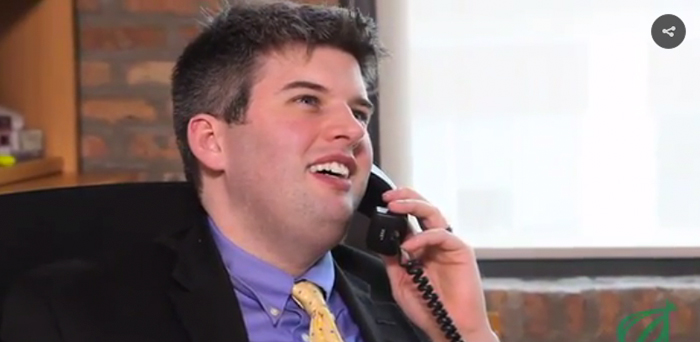5 Remarkably Heartfelt Brand Personalities Winning Buyers at Christmas
/0 Comments/in Brand Personality /by Lorraine CarterYour brand personality is the living, breathing manifestation of your company in the mind of your customer. Not to be confused with a mascot or spokesperson, your brand personality is an archetype that’s been carefully mapped out as part of your brand strategy. It provides direction for, and informs, your brand’s style, look and feel, messaging, tone of voice and more–all the critical elements that set your brand apart from your competitors’ brand personalities–making it stand out so you’re enabled to make your business a lot more profitable.
To be sure, a mascot or spokesperson can also be used as a tool help bring your brand’s characteristics to life, but they are simply part of the brand strategy process. Your brand personality lives in all elements of your branding, from the packaging design of your product to the look and feel of your premises. It helps define not only the right spokesperson and the personas of the leaders behind your brand but the style of your marketing, the brand stories you tell, the language you use to speak to your ideal audience and more.
Your brand personality differentiates you from your competition and helps you stand out in the marketplace, compelling people to buy. At no time is it more important to have a clear and well-defined brand personality than at Christmas, when hearts are yearning for sentimental stories and wallets are primed for spending.
It’s not just about warm fuzzy feelings though; brand personality has a direct impact on brand equity, which drives product sales[1]. It’s also one of the foremost factors in building brand loyalty[2], which increases sales volume by retaining customers and enabling you to charge a premium price for your goods and services3. Finally, your brand personality helps win brand ambassadors, who work even more effectively than paid sales reps to attract new fans to your company or organisation.
To help you infuse a bit of the Christmas spirit into your brand personality and maximize your quarter four earnings, take a cue from these five companies who’ve created remarkably heartfelt brand personalities that their ideal audiences can’t resist.
Related: Personality Matters: Bringing Your Brand to Life to Grow Profits
Five Heartfelt Brand Personalities Winning Buyers at Christmas
1. Whistle: Benevolent Brand Personality
Whistle is a GPS device for dogs that has developed a brand personality of benevolence.
In 2016, the company used this defining characteristic as the guiding force behind its ‘Never Lost Again’ Christmas campaign. For every Whistle unit sold during the campaign, the company donated another unit to an adoptable shelter pet to help increase adoptions4.
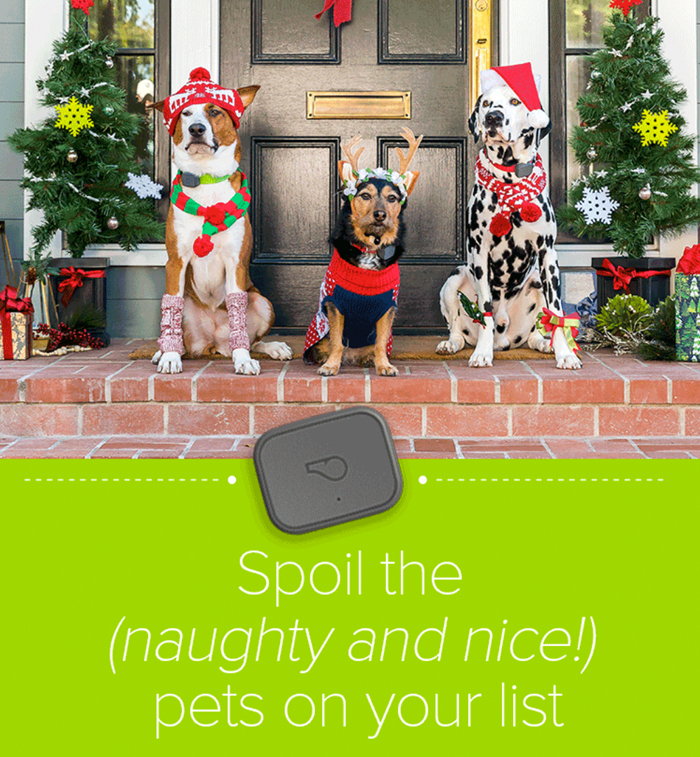
Image via Whistle
First and foremost, the company needed to create a campaign that would link the key personality trait of benevolence back to the brand. Instead of something generic like a monetary donation, which is nice but not necessarily mapped from the brand personality, Whistle used the donation of their physical product as the key campaign focus. This is in alignment with both their business model (selling pet GPS devices) and one of their brand missions (promoting shelter pet adoptions).
Next, Whistle needed to create a marketing video that reflects a spirit of benevolence to promote the campaign. By using the perspective of a puppy up for adoption in a scary, unfamiliar shelter, they’re able to show what a difference being adopted with the gift of a Whistle device makes in the life of a shelter pet.
You’ll notice that the video feels positive and big-hearted, a sharp contrast to some of the more bleak, tug-at-your-heartstrings pet adoption commercials that are sometimes seen on the airwaves this time of year. It comes down to a difference in brand personality. The goal of the campaigns is the same–increase pet adoptions–but Whistle uses elements like a conversational narrator and endearing background music to convey its brand personality of benevolence, which sets it apart from others with a similar mission.
Your brand personality must be systematically mapped through the process of brand profiling, which is a means for defining your brand promise, what sets you apart, how you stand out in the marketplace and why that matters to your customers. To learn more about our customised brand profiling and positioning services that will convey your brand value and create standout memorable distinction, contact us now.
2. Osh Kosh B’Gosh: Celebratory Brand Personality
Children’s apparel retailer Osh Kosh B’Gosh has a brand personality centred around the joy of having a child. According to the brand promise of its parent company, Carter’s, “you can count on [us] to take care of the little details so that you are free to focus on what really matters: celebrating your little one–and the hugs, cuddles, giggles, and babbles that light up our lives.”
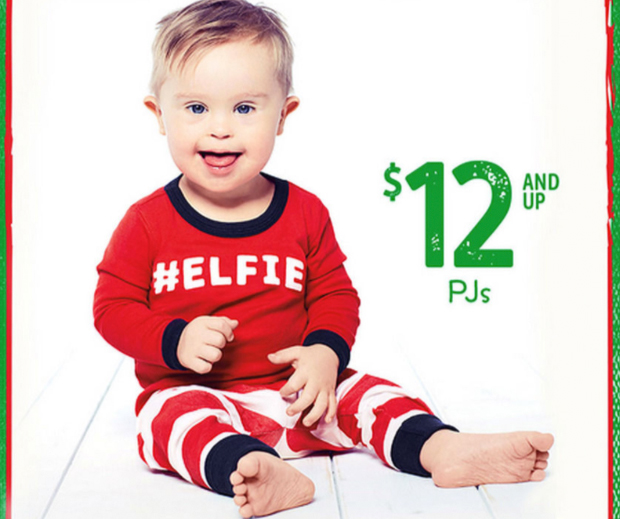
Image via Osk Kosh B’Gosh
In 2016, Osh Kosh B’Gosh made international headlines5 for featuring a child with Down syndrome in its Christmas advertising campaign–a departure from the models typically featured in children’s apparel ads. For those familiar with the Osh Kosh B’Gosh brand personality, though, the decision should come as no surprise. The brand has a clearly defined personality of celebrating all children that’s infused into every branding decision, which includes the actors and models who are cast in advertising campaigns. It makes perfect sense, then, that they’d be inclusive of a child with special needs.
When you have a well-mapped brand personality, it brings all of your marketing choices into alignment. If a decision doesn’t align with the personality you’ve defined, it’s easy to identify and correct course fast.
Related: Brand Profiling: Top 6 Components to Creating a Strong Brand Personality
3. WestJet: Impactful Brand Personality
Lots of companies have well-meaning ideas about making a difference, but Canadian airline WestJet lives out that goal by making impactful giving part of its brand personality.
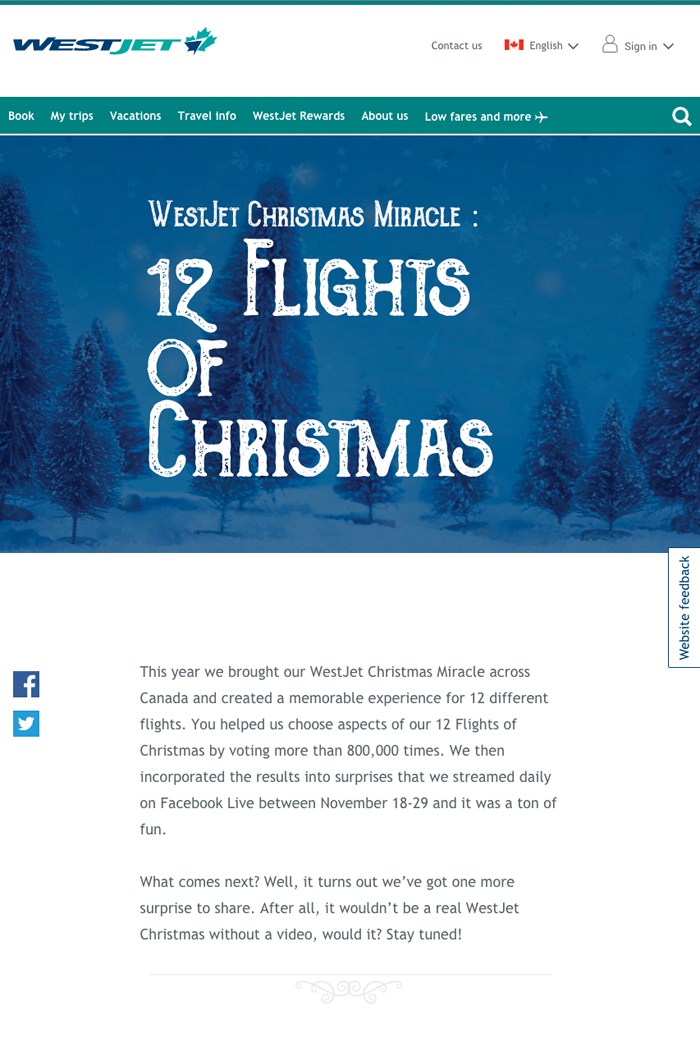
Image via WestJet
At Christmas in 2015, the company set in motion its ‘Mini Miracles’ campaign, appealing to its millions of followers to pool together and accomplish 12,000 mini-miracles in a 24-hour period.
The company uses the concept of impactfulness to guide every part of the Mini Miracles campaign, from the impact-focused language in the video (“Celebrate the good in others. Spread cheer. Deliver joy.”) to the video clips of people’s faces as they learn they’ll be receiving their own personal miracle, to the joyful photos of completed miracles on social media. The audience can see the impact taking place.
WestJet’s 2017 Christmas campaign follows a similar thread, taking viewers along for the ride as it hands out free flights in airports around Canada6. The brand personality guides the choice to have Santa Claus as the leading character, delivering free flight vouchers to unsuspecting fliers and capturing their reactions.
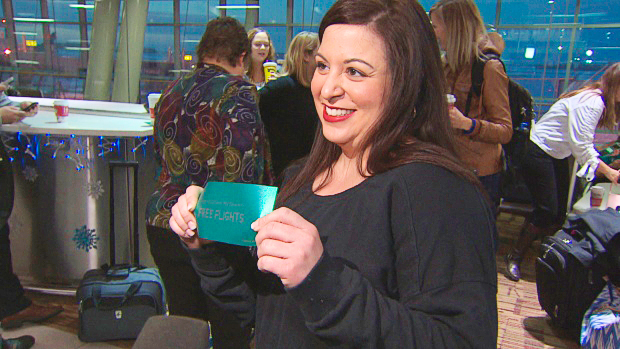
Image via WestJet
WestJet demonstrates how your brand personality carries through from campaign to campaign, year to year. The mascot and the execution might change–one year WestJet used an army of followers to carry out its mission, another year it used Santa Claus–but the underlying personality archetype remains consistent and helps define the brand in the minds of consumers.
4. TD Bank: Visionary Brand Personality
TD Bank lays out a clearly defined brand vision: “to be the better bank.” Achieving such a lofty goal takes a visionary brand personality. TD Bank is a great example of how a brand can use its own personality to connect with like-minded customers that share similar values–a key brand strategy for building loyal fans.
During its ‘Make Today Matter’ campaign, the bank gave customers the chance to turn their wildest ideas into reality7. The bank selected 24 customers with big ideas that would benefit their communities and gave the lucky individuals $30,000 to make those ideas happen. The catch? Each person had to carry out his or her plan within just 24 hours.
It’s easy to see how the company used its visionary brand personality to provide direction for all aspects of the campaign. First, it selected a wide array of diverse and thoughtful ideas to support, from a gala to benefit foster kids to a construction project on a neighbour’s home. Second, vision informed the campaign’s tightwire timeline; in order to execute a big goal in just 24 hours, you have to do some pretty visionary thinking. Finally, the bank focused closely on the vision of the ‘Make Today Matter’ recipients. Rather than using a narrator or spokesperson to explain what’s happening, we hear from the visionaries themselves via a series of heartfelt interview clips.
Related: Brand Personality: Is Your Brand’s Character Big Enough to Compete?
As we touched on before, personality isn’t about mascots or characters, rather it’s about consistent branding choices; in this case, TD Bank chooses to use not a spokesperson but real-life visionary customers as a mirror to reflect its own brand personality.
5. John Lewis: Sentimental Brand Personality
It wouldn’t be Christmas without a John Lewis advert. The retailer is known the world over for its sentimental, emotionally driven Christmas commercials, and its latest addition is no exception. In its 2017 advert, we follow a child as he discovers and gets to know an unlikely playmate.
First, consider the choice of the ‘monster’ to feature in the ad. Cuddly and a bit goofy, Moz the Monster is a far cry from the scary, shadowy figure most of us envision lurking under the bed as children. Yet because Moz is an unconventional and not-so-scary monster, we’re able to become sentimentally attached to him. It’s a choice driven by the brand personality.
Next, consider the tone of the video. From the cosy nighttime setting to a reimagined Beatles song as the musical soundtrack, the advert uses sentimental elements to set the tone and pull at our heartstrings. By the end, we’ve fallen in love with furry Moz and seeing him go feels bittersweet.
Related: 7 Universal Branding Lessons From Christmas Adverts
Christmas is an ideal time to play up the heartwarming elements of your brand personality, but it’s also an important opportunity to consider how brand personality guides your brand strategy choices all year long. B2B or B2C, small business or enterprise, product or service, brand personality is a relevant and essential component of the strategy for all successful brands. Remember, the buyer’s journey is an emotional experience rather than a logical one. Customers connect with brands in the same way they do with people, using personality traits to determine their feelings of brand loyalty, trust and likelihood to become repeat purchasers.
Do you have a clearly mapped personality? How is it defined? In what ways do you convey it to your audience?
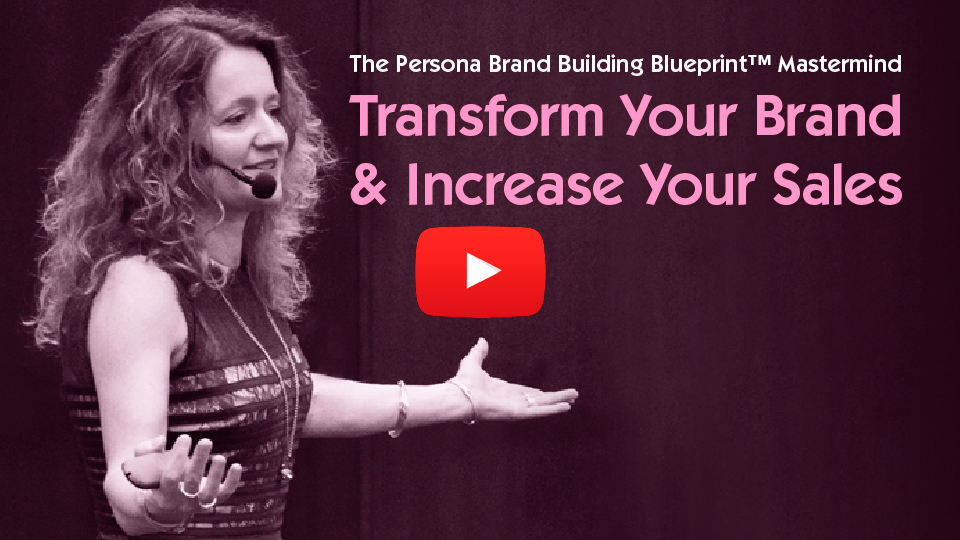
Build your standout brand at the Persona Brand Building Blueprint™ Mastermind with Lorraine Carter
Questions To Consider:
- What are the key personality traits you want customers to identify with your brand?
- What are the key personality traits of your competitors? How are you different?
- How does brand personality play a role in the decisions you make regarding branding, messaging and storytelling?
- Could you reevaluate your brand personality to make it stronger so it more effectively attracts your ideal customers and converts them into loyal fans to drive increased sales?
If you’re ready to define, map out, build and develop your brand personality as part of your brand strategy, take a look at our signature Personality Profile Performer™ Programme. It’s a step-by-step system that empowers you to infuse your brand with meaning in a way that builds lasting connections with your customers and ultimately drives increased profits.

Start building your standout, highly visible brand now with Lorraine Carter here
Sources
- https://pdfs.semanticscholar.org/5535/98c7b2bb5385a394563144b8a11fb5e3cd83.pdf
- http://www.ccsenet.org/journal/index.php/ijbm/article/viewFile/54062/30341
- http://scholarworks.calstate.edu/bitstream/handle/10211.3/173524/KumarKavita_Project2016.pdf?sequence=3
- https://finance.yahoo.com/news/whistle-launches-neverlostagain-one-one-223100669.html
- https://www.cbsnews.com/news/toddler-with-down-syndrome-stars-in-oshkosh-bgosh-holiday-ad/
- http://www.cbc.ca/news/canada/edmonton/westjet-gives-free-flights-to-passengers-at-edmonton-international-airport-1.4416261
- http://www.adweek.com/brand-marketing/ad-day-generous-td-bank-stunt-perfect-ad-watch-thanksgiving-161685/#/
Using Video To Broadcast Your Brand Message So You Attract Your Ideal Customers
/0 Comments/in Brand Message, Brand Personality, Brand Profiling & Positioning, Brand Strategy, Branding, Video /by Lorraine CarterThere are two important takeaways for you in this post about brand message using video:
- The first is that you don’t need to be a big-time corporation to publish a video that becomes popular. Today, if you have a smartphone, you can make a great marketing video to depict your brand message. A one-minute video highlighting the things that make your company unique could become your best customer acquisition tool yet.
- The second is that successful videos by SME / SMB businesses or solopreneurs are always about delivering a brand message with strategic intent. It’s got to give a value-add message or contribute towards enhancing your target customers lives. Alternatively, it needs to incorporate story building and showcase your brand’s characteristics. Injecting personality into a company’s online presence is what sets your business apart from the crowd so video is the perfect vehicle to showcase your brand at its best with its stand out personality.
Publishing a video just for the sake of it will not bring success because it’s the brand strategy behind the video content coupled with the people delivering the message to the camera, which makes it successful.
Related: Video Brand Strategy Top 11 Tips for How and Why You Need To Use Video
Codifying Your Brand Message to Stand Out and Create Great Videos to Attract Your Ideal Customers
Every business has its own brand, whether it’s strong because it’s been created with deliberate intent, or whether it’s weak and undeveloped as a consequence of a series of unplanned actions.
To codify your brand means to plan the messages you want to send out to attract your ideal customers and the manner in which you send those messages via the personality of your brand. Video is one of the brand strategy mechanisms for sending out those messages. Every message your business sends out must be in line with what you want your brand to be saying about itself and what it stands for — it’s purpose.
Related: Personality Matters: Bringing Your Brand to Life to Grow Profits
It’s often the case that SME / SMB businesses unintentionally neglect their own branding, to their detriment, because they lack the big brand know-how. Our mission is to empower business owners and entrepreneurs so they can transform their brands and increase their sales.
So the question here is, what’s the big deal about brands and branding?
Well, think of your brand as a store. What would it look like in a mall or shopping centre so it attracted the right customers? Because not all people or businesses will buy into your brand and what it stands for, and not all people or organizations need what you offer. So if your brand was a store you’d want to attract those for whom your product or service really meets their needs and is a great fit and deter those who are not really your ideal customers.
So. What would your brand look like if it was a store in a mall or online?
If you’re having trouble relating to this question consider asking these questions about your brand because the answers will provide some insight to help you codify your brand so it stands outs and attracts your ideal customers:
- What makes your brand unique?
- How do you want those you serve to feel when they’re doing business with you? For instance, is the experience uplifting, fun, spiritual, exciting, or something else?
- Who are your customers, or who do you want them to be? Picture them in your mind and describe them in detail.
- Who are your competitors and how do they compare?
- What problem does your company solve?
- Is your value proposition relevant to your customers?
- When people think about your brand, what feelings do you want to evoke?
- What kind of personality should your brand have in order to attract the right customers?
Codify who your brand is, it’s personality and promise, into a core concept that becomes the filter and directional reference for building and implementing your message and brand strategy.
If you want some direction developing your brand and your brand strategy so you can build your brand using really strong shareable videos then take a look at our brand building programme called the Personality Profile Performer™. This online course takes you through all the key steps you need to implement in building your brand. You can watch a free course preview here.

Want to create your strong brand message so it really attracts your ideal customers? Find out how here
Ring us today and discover how to make your brand message really stand out
Give us a call T: +353 1 8322724 (GMT hours 9:00-17:00) or drop us a line here to [email protected]. We’d be delighted to talk with you.
Use Video to Stand Out and Make Your Brand Matter to Your Customers Through Your Brand Message
Statistics show that on average, a person abandons a website, or blog post on a website, within 10 – 20 seconds[1] of arrival, but the average video holds 37%[2] of people’s attention right to its very end. Since the majority of videos are just under two minutes long[3], we can safely state that video is more effective at getting and keeping attention, than the written word alone.
In addition, according to SocialFresh[4], video produces the 2nd highest return on investment out of all content types:
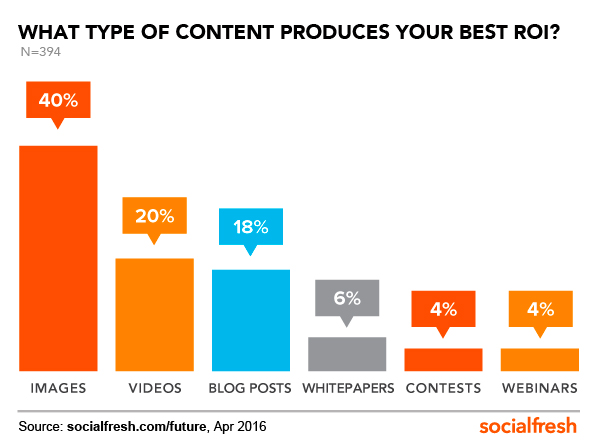
Image via SocialFresh
Reason enough to incorporate video as part of your brand strategy, right?
Related: From Zero to Hero; How To Become a Must-Have Brand
As a practical example, let’s take a look at Code.org[5], whose success is attributed to one smart video that happened to go viral…
Code.org, a nonprofit committed to bringing computer science education to all children, was founded in 2013.
In the video, co-founders Ali and Hadi Partovi interviewed the world’s top entrepreneurs, like Bill Gates and Mark Zuckerberg. They were questioned about their early experiences with computer programming.
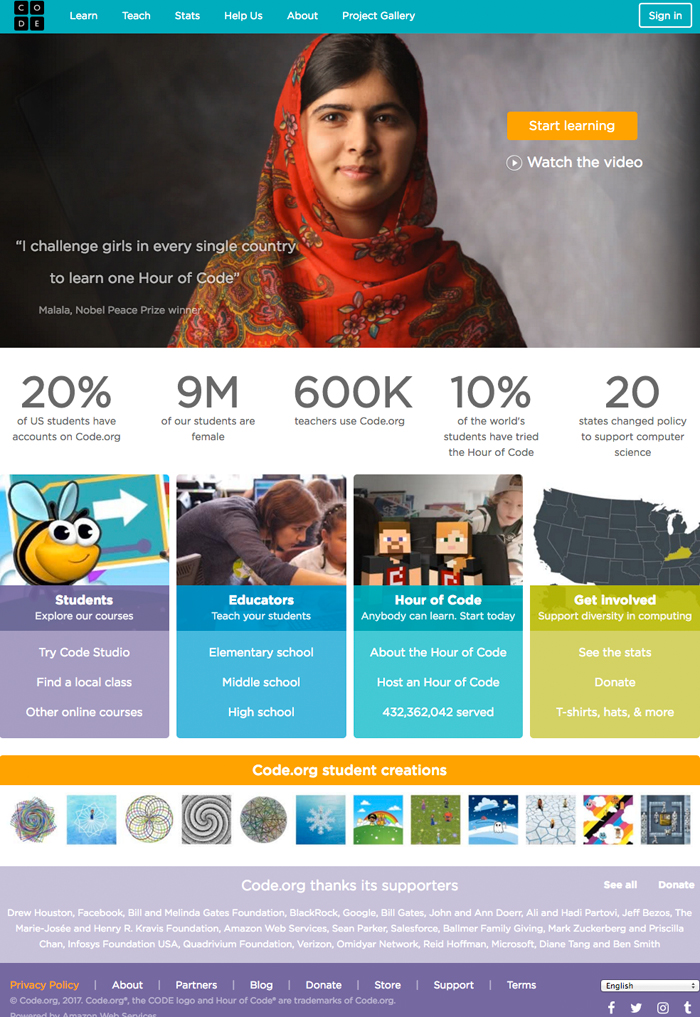
Image via Code.org
The interviews were edited down to a five-minute clip with the purpose of inspiring a new generation of coders and teachers.
The video, titled “What Most Schools Don’t Teach,” reached the number #1 spot on YouTube on its very first day. As a result, 15,000 schools reached out to Ali and Hadi for help after the video went live.
Today, just a few years later, Code.org boasts 15 million student accounts with 10,000 additional created every day.
Being a small non-profit, and to keep expenses down, the videos they distribute today showcase their staff instead of paid actors.
Have a look at their first video which launched their nonprofit:
What separates them from other struggling non-profits, is their strong brand vision which is carried out in everything they do.
Code.org’s brand strategy development has always been simple and consistent: it is to be inspirational to students (the video that went viral certainly is, providing motivation and inspiration to thousands), to “think big but act small”, to be personal, transparent, thankful and community-based. They are good at demonstrating their brand values in clear video brand messages.[6]
Related: Brand Profiling, How Brand Performance and Purpose Are Inextricably Linked
To Use Video To Share Your Brand Message You Don’t Have to be Bill Gates
To use video in your brand message does not mean you have to have the pockets of a Bill Gates. Anyone with a smartphone that can record a video has the means of video marketing!

Image via MarketingWeek
Many small businesses have successfully gained traction with video in various, affordable ways, like:
- Featuring their own employees
- Using their leaders
- Interviewing their customers
- Building brand stories
Related: Brand Stories: 5 Compelling Examples That Sell Themselves
A great example of affordable, but wildly popular branded videos, is Catmantoo who for one of the owner’s videos, got a whopping 7,858,920 views.
Catmantoo is owned by Robert Dollwet, a solopreneur who has no website but shoots videos that people love. They are actually ads, but you wouldn’t know it, which is precisely why they’re so popular. Robert sells all of seven products from his Facebook page[7] which has an extraordinary 959,145 likes:
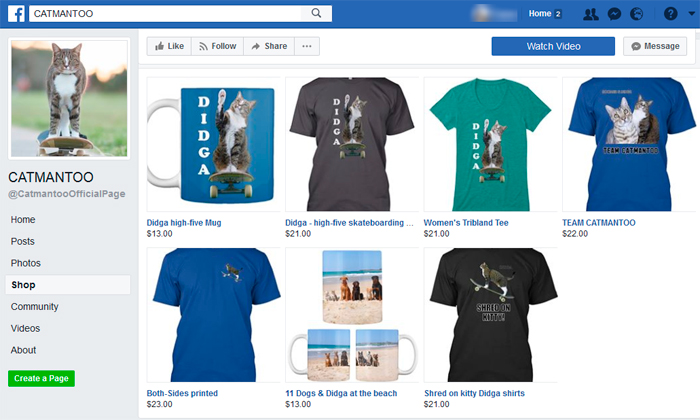
Image via Catmantoo
This entrepreneur uses the animals he trains to make entertaining videos. It’s pretty clear that his online success and cute cats are tightly intertwined; strong personality, compelling storytelling and clever brand strategy which achieves results. All his videos tell a story and then only briefly at the end, mentions Robert as the trainer of all the animals involved. Clever!
Discover how to build your stand out, customer attracting brand personality here so you can grow your business more profitably and faster.
You can demonstrate your product or services and broadcast your brand message just as effectively by video too. The key for video is either to add value, touch hearts or be entertaining because it’s only when you emotionally engage people positively that you’ll move them to buy.
Even the more traditionally conservative B2B service sectors can get it right, just like Taulia[8] who provides a cloud-based invoice, payment, and dynamic discounting management solutions. In a niche not widely recognized for blazing creativity, they’ve managed to carve a place for themselves by building a strong brand personality, creating entertaining videos that become beloved to their primary customers.
Related: Use Humour in Branding to Create Strong Emotional Bonds so You Increase Sales
In amusing worst-case-scenarios, Taulia demonstrates by video what can happen when you don’t use their services, not only giving a laugh but providing a humorous take on a serious B2B solution. Their videos build a connection between their customers, their brand and their company. Their videos have pushed them above their less creative competitors so they stand out and attract their ideal audience.
The proof is in the results – this brand attributes more than $125M[9] in their marketing pipeline to video content, and found that 45% of all closed-won deals had involved prospects watching their videos.[10]
The lesson here is that Taulia creates videos that appeal directly to its target audience. Bhaji Illuminati, Senior Marketing Manager explains, “Rather than trying to make one video that appeals to the entire world, we’ve learned that we can get stronger results by making many videos that appeal to specific audiences.”[11]

Image via MarketingWeek
Their primary branding strategy is to use humour and infuse personality into communications in order to deliver what might otherwise, in another format, be perceived to be a bit heavy going or not get noticed at all by their target audience. With your phone, you can also use Facebook Live to host a live video broadcast, similar to a webinar, to your primary audience and followers and make it a highly interactive experience.
Conclusion
If other entrepreneurs and small business owners have accomplished great success sharing their brand message through videos, so can you. All you need is a smartphone, good planning and a clear, well-developed brand strategy. Find out more about how you can build your brand here.
Questions to consider
- How can you inject vibrant personality into your brand message using video so it stands out and attracts your ideal customers?
- What would your brand look like if it was a store in a mall, what are its key stand out elements to attract your ideal customers and how can you convey that in a video?
- What are the key factors you need to integrate with your brand strategy to increase your sales?
Want to develop your brand so you can increase your profits but you’re not sure where to start to get a successful return on your investment?
If you want direction and support empowering you to transform your brand so it increases your sales then the Persona Brand Building Blueprint™ Mastermind is the perfect fit for you.
This is a two-day brand building intensive shared with a small group of like-minded peers where you work on your brand with our leadership. In fact, over the two days, you reevaluate your brand, codify it and create your brand strategy from the ground up whether you’re revitalising an existing brand or creating a new one.
This is a highly empowering workshop where we take a deep dive, step-by-step into how to build a brand. You discover and apply the systems and methodologies used by some of the world’s greatest brands as you work on your brand under Lorraine Carter’s direction and tutelage so you can grow your own brand and business.
This is not a theory based programme but a highly interactive fast-track course where you work intensively on your brand throughout the programme duration using our ten step system to:
- Completely re-evaluate your brand to make it much stronger so it’s highly visible enabling you to increase your profits
- Map out your brand in full so it’s codified and comprehensively documented to grow your business faster
- You leave with your total brand road map or GPS of your brand empowering you to manage your brand, stand out and attract your ideal customers so you multiply your sales
Outcome: Your brand transformed so you can increase sales.
At the end of the two-day Persona Brand Building Blueprint™ Mastermind you leave with your fully documented brand strategy ready for implementation in your business or organisation.
If your team is larger and you’d like to include everyone’s’ participation in the Persona Brand Building Blueprint™ Mastermind then we also run in-house private client brand building intensives tailored to your specific needs too.
Just drop us a line to [email protected] or give us a call T: +353 1 8322724 (GMT 9:00 – 17:00) to discuss your preferences and we’ll develop your brand building intensive bespoke to your particular brand requirements so that you’re empowered to develop your brand and take your business further a lot faster.
[1] https://www.websitemagazine.com/blog/5-reasons-visitors-leave-your-website
[2] https://blog.hubspot.com/marketing/video-marketing-statistics
[3] https://blog.hubspot.com/marketing/video-marketing-statistics
[4] https://www.ibm.com/think/marketing/social-keeps-mobile-marketing-tactics-current/
[5] http://www.code.org
[6] https://code.org/about/values
[7] https://www.facebook.com/pg/CatmantooOfficialPage/shop/?ref=page_internal
[8] https://taulia.com/en/
[9] http://www.dmnews.com/marketing-strategy/taulia-a-b2b-brand-with-a-strategic-approach-to-video-marketing/article/345971/
[10] https://www.clickz.com/b2b-companies-can-buck-the-norm-and-win-big-in-marketing/26174/
[11] https://www.vidyard.com/blog/how-taulia-became-a-video-marketing-powerhouse/
Strategic Brand Partnerships: Does My Brand Look Big in This?
/0 Comments/in Brand Collaboration, Brand Partnerships, Brand Personality, Brand Positioning, Brand Profiling & Positioning, Brand Strategy, Co-Branding, Partnership Branding, Strategic Partnerships /by Lorraine CarterIn branding, it turns out that bigger is better together. In successful strategic brand partnerships, the branding strategy of two plus two can equal five…or more!
Before jumping into bed together, several questions need to be asked – and answered. It’s essential to be clear and consistent about your values and your vision and to bring that conviction to the relationship from the start.
“Relationships between companies begin, grow, and develop—or fail—much like relationships between people”. – Harvard Business Review[1] |
Objectives of Strategic Brand Partnerships
Strategic brand partnerships are a “win-win” for both parties, delivering a great return on investment when done well while reducing marketing spend internally. It’s important to develop SMART* goals though and a plan for tracking and measurement of ROI in advance.
Partnering with the right business achieves:
- Brand recognition
- Increased visibility
- Inherited reputation
- Validity and credibility
- A pathway to an expanded target audience
“No matter how brilliant your mind or strategy, if you’re playing a solo game, you’ll always lose out to a team.” |
* Watch for an upcoming post covering SMART objectives for brand awareness.
10 Things Brands Must Look for in The Right Brand Partnerships
Successful brand partnerships between smaller and larger or better-known brands can work when there are mutual gains and wider distribution to be achieved by both brands. Both partners must examine the opportunity for synergy by first reviewing each of the following:
- Common brand values
- Complementary brand cultures
- Core competencies
- Mutual benefits; a “win-win”
- Alignment between products or services
- Enriched customer experiences
- Articulation of a clear brand road map
- Resources available
- Ability to reach a wider customer audience
- Mutual trust
If your brand is the smaller partner in the relationship then you need to ensure you have your brand fully codified and mapped out so you can critically evaluate who would potentially be a good partner for you.
Ensuring your brand is properly profiled with its personality, positioning and purpose fully articulated and documented means you’re also more fully equipped on an equal footing to engage with the larger player because they will have all their brand essentials including their brand guidelines fully documented so you want to level the playing field before approaching the deal!
If you want some direction developing your brand and your brand partnership strategy then take a look at our brand building programme called the Personality Profile Performer™. This online course takes you through all the key steps you need to implement in building your brand. You can watch a free course preview here.

Build Your Stand Out Customer Attracting Brand Using The Personality Profile Performer™ Programme with Lorraine Carter
Alternatively, if you want in-person professional direction with expert input to develop your brand and brand partnership strategy and would like to discuss working with us then give us a call T: +353 1 8322724 (GMT hours 9:00-17:00) or drop us a line to [email protected]. We’d be delighted to talk with you.
Related: How to Use Brand Positioning to Build Brand Impact in an Overcrowded Market
Successful Mixed-Size, Mixed-Use Brand Partnerships
Sometimes a brand partnership appears unlikely at first glance. A beverage and a nail polish; a social network and an airline; a music app and yogurt. How and why are these brand partnerships workable? Or even utterly brilliant?
The biggest innovation in media prize went to Burger King when the fast food brand sassily and publicly pitched McDonald’s. The much bigger, better funded golden arches folks declined to co-brand “McWhopper” for a day. Let’s take a closer look at each example.
| PARTNER 1 | PARTNER 2 | BRAND 1 | BRAND 2 |
| Destination | Satellite & Cable TV | NYC & Co. | Nickelodeon |
| Top end designer | High Street retailer | Karl Lagerfeld | H&M |
| Music app | Yogurt | Spotify UK | Danone “Light & Free” |
| Social network | Museums | UNESCO #Museum Week | |
| Soft drink | Nail varnish | Coca-Cola | OPI |
| Online dating | Airline | Tinder | Delta Air Lines |
| Ride Share app | Fast food giant | Lyft | Taco Bell |
| Fast food giant | Fast food giant | McDonald’s | Burger King |
Related: Co-Branding: 13 Tips for Growing Your Brand Through Strategic Partnerships
Take a look at these brand partnerships a bit more closely because there are valuable learnings and takeaways you can apply to grow your business too.
NYC & Co. | Nickelodeon
Brand Partners:
NYC & Company, New York City’s official destination marketing organization, announced Nickelodeon’s Teenage Mutant Ninja Turtles will continue their role in 2017 as Official NYC Family Ambassadors. The co-branded national ad campaign highlights New York City as a family-friendly destination. Its activation allows visitors to pick a turtle to explore a topic.
Why It Works:
It’s fun. A popular, compelling cartoon family become the official brand ambassadors and tour guides for real families who make up about one-third of NYC’s 60 million annual visitors. The campaign’s activation allows kids to pick a turtle to explore a content topic.
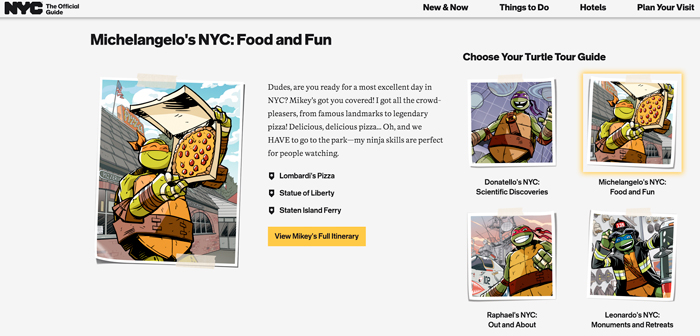
Image via nycgo – NYC Turtles
Related: Personality Matters, Bringing Your Brand to Life to Grow Your Profits
Karl Lagerfeld | H&M
Brand Partners:
The collaboration that changed everything is revived once or twice a year with other top-end designer brands. It seemed incredible when introduced in 2004[3], a partnership between Karl Lagerfeld, haute couture fashion icon, and a mass market clothing chain. The in-store collection that was meant to last two weeks sold out to frenzied shoppers in 25 minutes in many of the retailer’s 1,000 locations.[4]
Why It Works:
Initially shocking, now it’s cool to make luxury apparel affordable. Both brands have reached new markets. The choice of designer is kept quiet in advance, and the collections’ resale market is as vibrant as the pieces that fly out the doors on opening day.
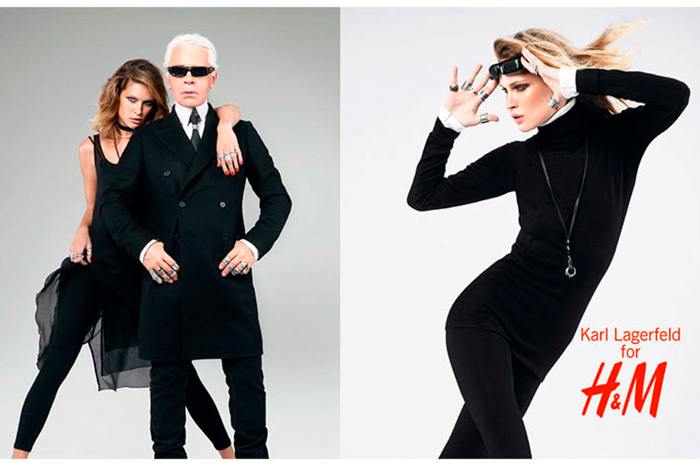
Image via Harper’s Bazar UK
Spotify | Danone
Brand Partners:
What does yogurt sound like? Danone signed a year-long deal to associate its ‘Light & Free’ brand with Spotify ‘Chill’ moments, targeting listeners, artists, and influencers to create chillout playlists with ads for yoghurt.
Why It Works:
Pairing up products with moods resembles the way music reflects moods. Both brands suggested that consumers “really enjoy the feeling of ‘Light & Free’ at first hand.”
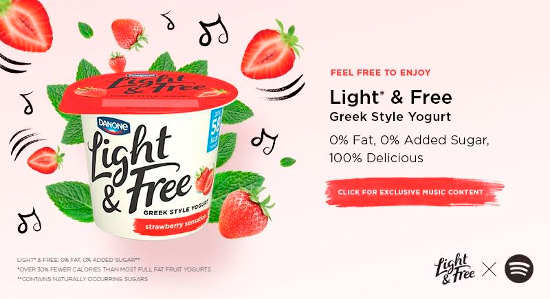
Image via Event Magazine, Danone, Spotify
Twitter | Museum Week
Brand Partners:
The first-ever #MuseumWeek launched in 2014 with Twitter as a partner. Hundreds of cultural institutions and heritage landmarks across Europe tweeted out 140-character bursts of inside information, facts and trivia to promote sharing and pique curiosity. Powered by UNESCO, it’s an annual success.
Why It Works:
Nobody gets museum fatigue. Twitter is the perfect partner for pumping out fascinating, compelling conversation-starter tidbits: “Did you know a bluestone weighs 2 tons, the same as 22 sheep?”
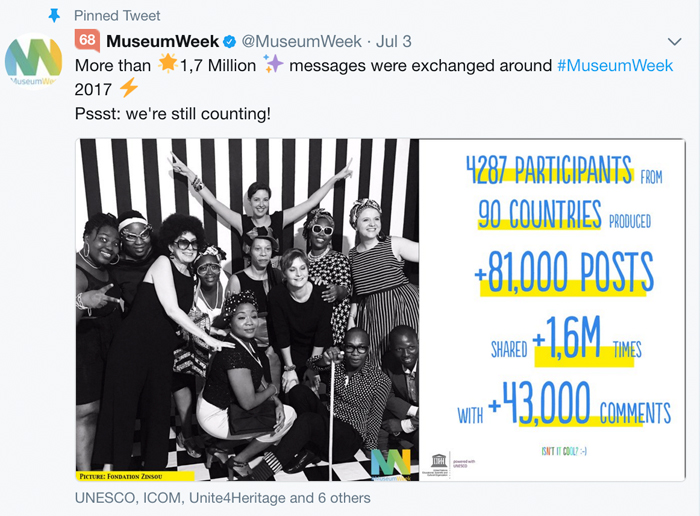
Image via Twitter
Coca-Cola | OPI
Brand Partners:
Paint your nails a flavour? Coca-Cola Red, of course. ABC News reported, “It may seem like an oddball pairing, but the connection between Coca-Cola and beauty products is not unprecedented…Coca-Cola said that partnerships with nail polish and lipstick brands actually date back to the 1940s. More recent products include Bonne Bell’s Coca-Cola flavoured lip balms.”[5]
Why It Works:
Both brands are pitching happiness in a bottle to an important female customer segment. For the nail polish, the association says, “I’m a classic.” For Coca-Cola, the association says, “I’m hip and happening.”
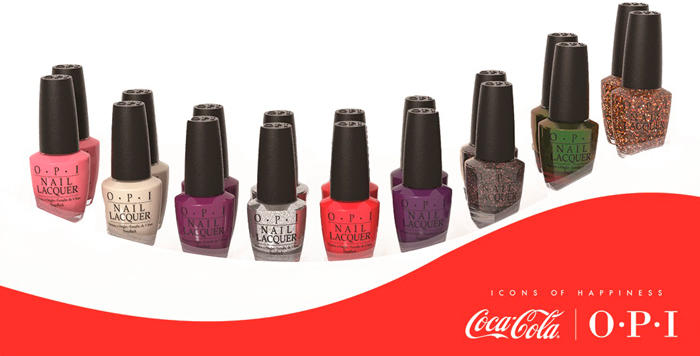
Tinder | Delta Air Lines
Brand Partners:
Delta’s promotional partner Tinder says, “World travellers are more likely to be swiped right.” On their Facebook page, AdWeek proclaims “Bravo, Delta.” The creative teams painted famous international landmarks on a Brooklyn, NY #DeltaDatingWall for selfies.
Why It Works:
Because travel is a turn-on. Because selfies are instantly shareable. And because data supports the validity of the claim. Both partners reach a prime customer audience in a densely populated, trendy neighbourhood.
- 62 percent of men and 74 percent of women want a partner who shares their travel interests
- 1 in 2 singles say travelling is one of their favourite things to do
- 1 in 2 singles say travelling to a new city to meet a date would be exciting
- 1 in 3 singles ranked travel as a top priority in 2017
- 57 percent of singles take 1+ vacations year
- 1 in 3 singles try to go somewhere different for vacation every time they travel
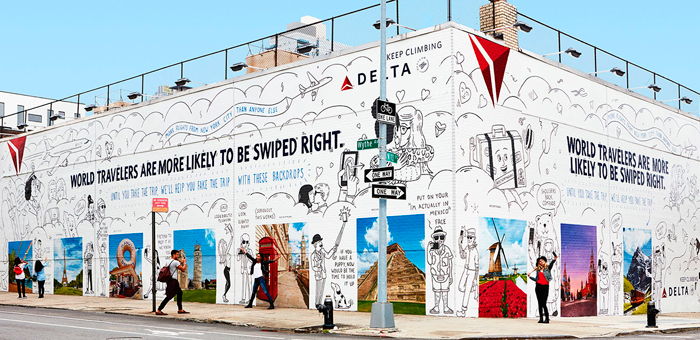
Image via AdWeek
Lyft | Taco Bell
Brand Partners:
Lyft (a Uber competitor) is partnering with Taco Bell to satisfy your late night hunger pangs. Taco Mode encourages Lyft riders to make a pit stop at a California Taco Bell fast food location for a free Doritos Locos Taco before reaching their final destination. Request to be collected in a Taco-themed car between 21:00 p.m. to 2 a.m.
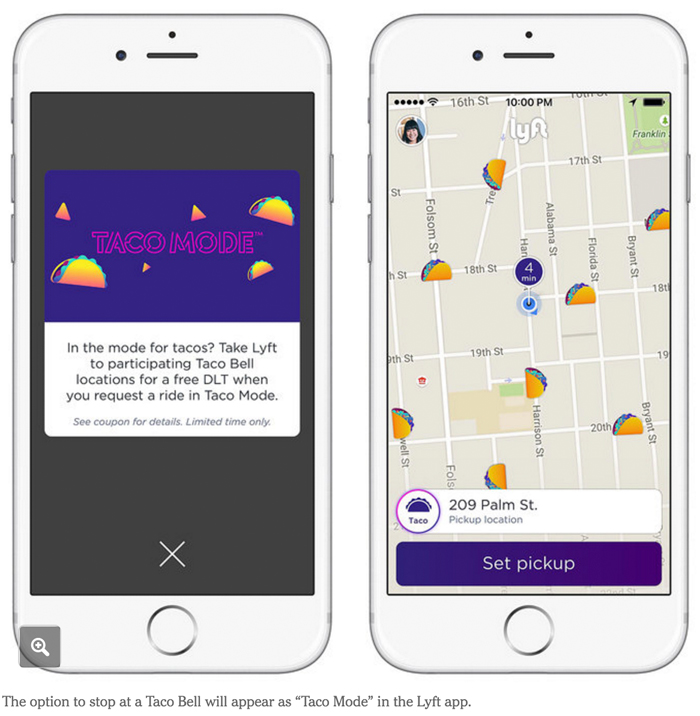
Image via New York Times
Why It Works:
The emphasis is squarely on the customer experience. Taco Bell tells the New York Times[6] this partnership represents a new type of “experience innovation,”[7] delivering customers to the food instead of vice versa.
McDonald’s | Burger King
In the best partnership that never happened, Burger King got everyone talking when they publicly proposed a ceasefire on burger wars in an open letter to McDonald’s. In full page ads, Burger King suggested a hybrid McWhopper to mark World Peace Day. While McDonald’s rejected the tongue-in-cheek partnership, BK’s 2016 print campaign won a Grand Prix at the Cannes Lions festival. (Just what Burger King wanted: Attention!)
Related: Use Humour in Branding to Create Strong Emotional Bonds so You Increase Sales
SMEs and Co-Branding – Leverage These Brand Partnership Ideas to Grow Your Business
Strategic partnership brand strategy can be especially fruitful for startups and small-to-medium sized companies that find the right collaborator in a bigger brand. By engaging with a like-minded big brand buddy, a smaller brand can build traction, momentum, and credibility while stretching their branding budget.
This works especially well when a bigger brand is launching in a new market, hence it must behave like a small brand, as there’s not yet brand awareness. Carabao Energy Drink was unknown when it was recently introduced in Europe while enjoying a strong second place standing in its category in Thailand with 21 percent market share.
However, small and big isn’t an exclusive combination solution. Two small brands or two big brands can also support one another very effectively as evidenced here in the four case studies detailed below.
| PARTNER 1 | PARTNER 2 | BRAND 1 | BRAND 2 |
| Energy drink | Sports teams | Carabao Energy Drink | English Football League |
| Online dating | Dining app | Match.com | Grub Club |
| Destination | Bank | Tourism Authority of Thailand | Krungthai Bank |
| Supermarket chain | TV show | Coles (Australia) | MasterChef (Australia) |
Related: From Zero to Hero, How to Become a Must-Have Brand
Want to develop your strategic partnerships branding strategy so you can grow your brand awareness, increase your sales, expand your market reach but you’re not sure where to start to get a successful return on your investment?
Just drop us a line to [email protected] or give us a call T: +353 1 8322724 (GMT 9:00 – 17:00) — we’re here to help.
If you want direction and support transforming your internal branding strategy so it empowers your team and increases sales then the Persona Brand Building Blueprint™ Mastermind is the perfect fit for you.
This is a two-day brand building intensive shared with a small group of like-minded peers where you work on your brand with our leadership. In fact, over the two days, you reevaluate your brand, codify it and create your brand strategy from the ground up whether you’re revitalising an existing brand or creating a new one.
This is a highly empowering workshop where we take a deep dive, step-by-step into how to build a brand. You discover and apply the systems and methodologies used by some of the world’s greatest brands as you work on your brand under Lorraine Carter’s direction and tutelage so you can grow your own brand and business.
This is not a theory based program but a highly interactive fast-track course where you work intensively on your brand throughout the programme duration using our ten step system to:
- Completely re-evaluate your brand to make it much stronger so it’s highly visible enabling you to increase your profits
- Map out your brand in full so it’s codified and comprehensively documented to grow your business faster
- You leave with your total brand road map or GPS of your brand empowering you to manage your brand, stand out and attract your ideal customers so you multiply your sales
Outcome:
Your brand transformed so you can increase sales.
At the end of the two-day Persona Brand Building Blueprint™ Mastermind you leave with your fully documented brand strategy ready for implementation in your business or organisation.
If your team is larger and you’d like to include everyone’s’ participation in the Persona Brand Building Blueprint™ Mastermind then we also run in-house private client brand building intensive programmes too.
Ring us to discuss your brand building preferences
Just drop us a line to [email protected] or give us a call T: +353 1 8322724 (GMT 9:00 – 17:00) to discuss your preferences and we’ll develop your brand building intensive bespoke to your particular brand requirements so that you’re empowered to develop and lead your internal brand building team.
Related: How Do Challenger Brands Become Market Leaders?
Carabao | English Football League
Brand Partners:
Carabao is a Thai energy drink with good market share. However, the brand was unknown in the UK, part of its European launch. Carabao is a principal partner of both Reading FC and Chelsea FC.
Why It Works:
Pro sports and energy drink are an obvious dynamic pairing. The English Football League and its 92 member clubs got a shot of adrenaline when Carabao signed on for three years of title sponsorship. Carabao got instant brand recognition as a major player in its new territory.[8]
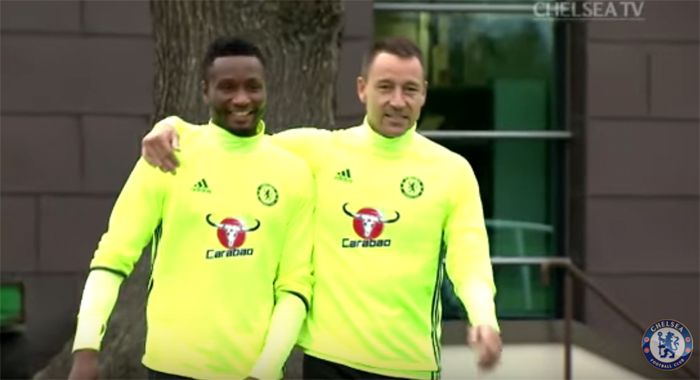
Image via Chelsea FC TV
Match.com | Grub Club
Brand Partners:
Grub Club connects chefs with underused spaces for pop-up dining. Diners are delighted by quality food in quirky places. The supper club startup was founded in London in 2013. Grub Club hosted an après ski-themed evening with Match.com, one of the largest dating sites.
Why It Works:
Dinner = Date Night. Even if it’s over the top for a first date, Grub Hub engages with an established like-minded web-based company that acts as a big brand buddy, helping them build brand momentum and credibility. The bigger brand gets access to a closely aligned niche.
“Very few startups have any marketing budget so the only way to get your brand out there is by setting up strategic partnerships with companies big and small.”[9] – Siddarth Vijayakumar, Co-founder of Grub Club |
Related: The Case for Brand Disruption, Be The Disruptor or Be Defeated
Tourism Authority of Thailand | Krungthai Bank
Brand Partners:
Medical tourism meets beach holidays. The largest bank in Thailand partnered up with the national tourism office to promote the destination for people who combine treatment with travel.
It’s a large and growing international trend, and Thailand is a leader in the market.
Why It Works:
A health and wellness website[10] highlights popular treatments available in Thailand as well as providers. The bank offers tourists the Miracle Thailand Card, a free visitors’ debit card that carries some medical and life insurance coverage and is accepted at 286 hospitals.

Image via Thailand Tourism
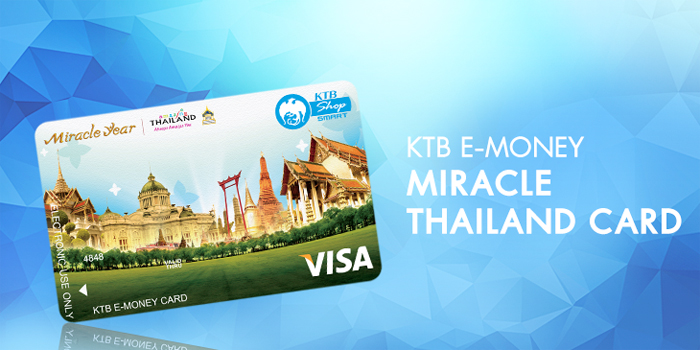
Image via Krungthai Bank
Related: Brand Management: Top 10 Tips for Managing Your Brand Reputation
Coles | MasterChef
Brand Partners:
Business surged when the Western Australian supermarket chain launched “To cook like a MasterChef cooks, shop where a MasterChef shops” as a campaign tied to recipes used on the reality TV show.
Why It Works:
How about a 30 percent uptake overnight in the meat sales for a MasterChef beef stroganoff dish?[11] From spices to cooking equipment, the grocery store chain says revenue is soaring. For MasterChef, the positive impact on expanded viewing audiences tuning in for the next bright cooking idea is built right into this “win-win” partnership. After all, everyone regularly goes grocery shopping.
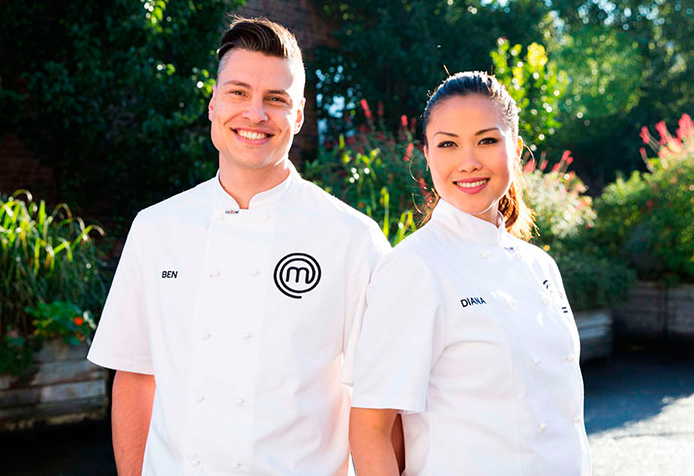
Image via TenPlay TV MasterChef
So the question is, have you considered strategic brand partnerships to increase your brand awareness, market reach and sales? Scale and size is not an excuse because this is a brand strategy open to large and small with innovative thinking — once you have a few fundamentals in place, like codifying your brand as previously mentioned.
Consider Strategic Brand Partnerships to Increase Your Customer Base and Grow Your Sales Fast
- Do you have a marketing budget dedicated to brand partnership opportunities?
- Do you have clear objectives in mind for a potential co-branding campaign?
- Do you have one or more potential co-branding partners in mind for your business?
- What innovative co-branding or brand partnerships have impressed you lately?
Related: Brand Profiling, How Brand Performance and Purpose Are Inextricably Linked
[1] https://hbr.org/1994/07/collaborative-advantage-the-art-of-alliances
[2] https://www.forbes.com/sites/danschawbel/2012/02/14/10-memorable-quotes-from-the-start-up-of-you/#1b2295315b3c
[3] http://about.hm.com/en/media/news/karl_lagerfeld_and_hm.html
[4] http://wwd.com/fashion-news/fashion-features/truly-fast-fashion-h-m-8217-s-lagerfeld-line-sells-out-in-hours-593089
[5] http://abcnews.go.com/Lifestyle/coca-cola-manicure/story?id=23713099
[6] https://www.nytimes.com/2017/07/25/business/media/lyft-taco-bell.html
[7] https://www.youtube.com/watch?v=brJoJlRu_0Y
[8] https://www.youtube.com/watch?v=DBggju4mBGE
[9] https://www.marketingweek.com/2014/02/12/start-ups-and-big-brands-join-forces-for-mutually-beneficial-partnerships/
[10] http://thailandmedtourism.tourismthailand.org
[11] http://www.theaustralian.com.au/business/media/masterchef-sparks-coles-sales-surge/news-story/e6ef72e4b4f1793a9bd453fc7936970d
How to Develop Your Brand Tone of Voice to Increase Sales
/0 Comments/in Brand Personality, Brand Profiling & Positioning, Brand Tone of Voice, Brand Voice, Branding, Communication /by Lorraine CarterBring to mind someone you love and know well. When they announce happy news, how do they do it?
It may be because of their personal brand type they give you the message as they bound into your home, all high-energy and dramatic, practically jumping up and down until you take the bait and ask them what they have to say. Or it could be they wait with calm, measured control until dinner is served, the family gathered at the table, before they quietly tell their news.
All people are different.
Each of us, according to our personality, convey messages differently. And it’s the same for brands and businesses. Each has it’s own personality and each delivers messages with a specific brand tone of voice.
The world’s best, most loved brands are those who have mastered brand tone of voice. The company’s personality shines through and it delivers messages in a tone that resonates with a specific group of people; their target audience.
In this article, we’ll take a look at what brand tone of voice is, how to develop it, and examples of companies who lead the way. A strong brand, with a strong tone of voice, will overtake its competitors and attract the right target audience. The result for the brand owner is increased sales.
What Is Brand Tone of Voice?
A brand’s voice is the personality it conveys, and which shines through in all it communicates. A brand’s tone of voice, is how the message is said. Online, brand tone of voice is the attitude of your content.
Right now, your brand already has a voice, as well as a tone of voice. The big question is this: what does your brand voice convey to your target audience?
For instance, does your brand say, “Thank you, Jeff!” or does it say, “Thanks, Jeff.”?
Things to consider for conveying tone of voice:
- Is your brand more formal or casual?
- On social media and in emails, do you use slang or emoticons?
- Do you make up your own words, like “peeps” for “people”, or “delish” for “delicious”?
- How does your brand use punctuation?
- Do you use humour and if so, how?
Once you decide on the tone of voice you want to convey, through the brand profiling process, you need to do it consistently. If you have a team of people working with you, it can be especially difficult to keep your branding elements consistent.
In fact you will need to develop a brand style guide so you can manage and protect your valuable brand assets effectively. A comprehensive brand style guide will also help you avoid unintentional brand self sabotage or the dilution of your brand. In truth a brand can never have major impact or become very strong unless it is intentionally developed, managed and controlled using brand profiling and brand guidelines.
One company that does an exceptional job with their brand tone of voice is Mailchimp, an online email marketing and automation platform. To keep their brand consistent, they created a comprehensive style guide[1]:
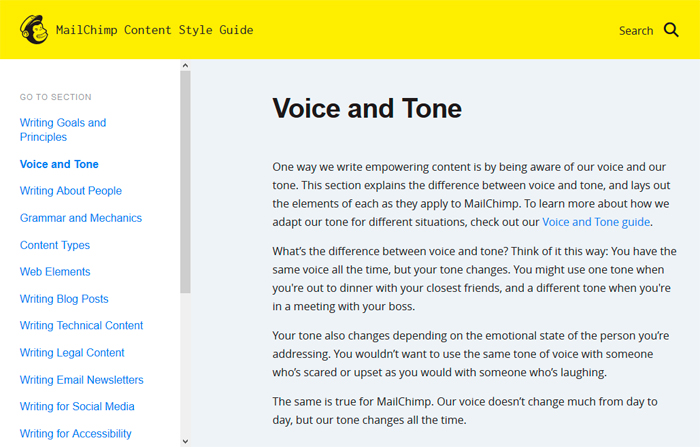
Image via MailChimp
Have a look at a screenshot of their YouTube videos – you can see just by the video images on their channel page, that their brand style guide works beautifully to keep their branding consistent:
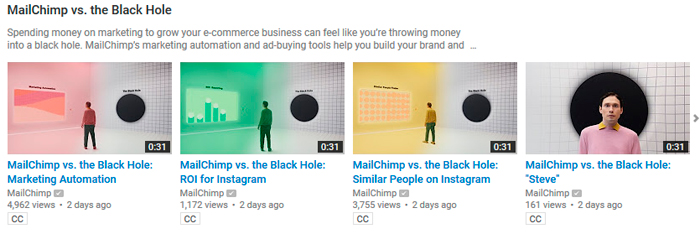
Image via MailChimp
Watch one of Mailchimp’s videos to get their full brand tone of voice experience:
What is your brand tone of voice telling people about who you are, and does it resonate with your target audience?
Related: Use Humour in Branding to Create Strong Emotional Bonds so You Increase Sales
Your Brand Tone of Voice Must Speak to Your Target Customer
Every business – including B2B’s – sell to people. It’s the people in companies who make decisions. The solutions you provide cater to a certain group of people or companies.
Before your business builds a branding strategy, it would need to create purchaser personas, fictional characters who embody and fully represent your ideal customer.
All branding should be built on the target customer at its core because you can’t effectively sell to people you don’t understand. You have to speak their language: what keeps them up at night? What are the problems they have that you can solve? What do they love? And so on.
Every business has a minimum of between two to twenty different ‘Purchase Personas’ so it’s essential you identify and map out each of your different customer types because you need to understand your target audience; their needs, wants, loves, hates and aspirations intimately, in order to maximize your brand strategy impact.
In fact, this exercise is one of the key elements in our brand building programme called the Personality Profile Performer™. As you map out each of your different customer types using the ‘Purchaser Personas’ system, the outputs provide the critical insights and direction for how your brand tone of voice is built to speak to your customers on their terms so they find your message compelling — winning their hearts and minds on their terms — so you can grow your business. The course also takes you through all the critical steps you need to build your brand tone of voice. You can watch a free course preview here.
Alternatively if you want in-person professional direction and expert consulting support to build your brand and would like to discuss working with us then drop us a line to [email protected] or give us a call T: +353 1 8322724 (GMT hours 9:00-17:00). We’d be thrilled to chat with you.
The Ritz-Carlton Hotel[2] is a case in point. In 2015, they launched their new brand voice; their goal being to create a refreshed, relevant voice that firmly positioned the hotel in the luxury top tier.
Related: Luxury Branding: How to Establish or Re-Position Your High-End Brand
To this effect, they used consumer insights on their target audience, getting feedback from more than 3000 “luxury” customers around the world.
Video via: Ritz-Carlton Hotel
Is your brand tone of voice resonating with your target audience?
Related: Brand Voice: Differentiating Through Your Own Brand Language and Attitude
Brand Tone of Voice and Word Style
Words impact your brand’s tone of voice, message style and personality in every single piece of communication, whether offline or online, whether it’s your HR department putting recruitment adverts in newspapers, the emails your employees send out, mobile text messages, frontline call centre language and phone scripts, social media responses, flyers, business cards, blog articles and so on.
Everything the public can see about your business is a message you’re sending out.
This message can either help or harm your reputation, so it has to be carefully crafted.
Related: Brand Crisis – How to Manage, Survive and Thrive
A brilliant example of brand word styles is provided by Donald Trump in his fight for presidency in 2016. In this next video, we take a look at the difference between the Donald Trump and the Russell Brand brands.
While Trump uses small, common, simple words, Brand uses uncommon, more complicated, sophisticated words. The way they speak is not by accident, but rather by design. Trump understands that shorter, simpler words are understood by a larger number of people while longer, less common words may carry more precision to a specific audience profile:
Video by Charisma on Command
Now unlike Donald Trump who made his billions long before he became the US president, Pat Flynn[3] is a well-known and respected online marketer who started his business ventures from nothing. In fact, in 2008 he was laid off from his job and forced to make a living doing something he knew nothing about: online marketing.
Related: What Brands Can Learn From Political Campaigns
In a world of sometimes less than honourable, online scams, Flynn brands himself as an ethical marketer. As such, he is open about his family and his life. To back up his “ethical-ity”, on the home page of his website, he’s given prominence to his monthly earnings. When the visitor clicks on it, they can choose to view monthly income reports.
Image via Smart Passive Income
Watch for the words and tone of voice Flynn uses in one of his videos:
Video by: Smart Passive Income
Flynn portrays himself as a humble, transparent family man who cares about his customers and visitors alike, whose principled and who can be trusted. This ultimately leads to increased sales; that’s the power of his brand’s tone of voice.
Whether your business is small, medium or a large conglomerate, your brand is sending out messages via the words it uses and how it behaves through its personality.
Brand Tone of Voice in Social Media
If your brand is participating on social media platforms, you are sending out messages to the public at large, and to potential prospects.
Unfortunately, because social media marketing is still in its relative infancy, many businesses just don’t get it right, and small to medium sized companies have a real struggle to understand and use social media to optimize their earnings.
But one small company has mastered social media tone of voice, and that is MOZ, an SEO consulting company with a staff complement of less than 150.
MOZ has a heavy online presence and is beloved by the SEO community. Why? The content they produce is clever, bright and fun. SEO being a very complex and sometimes technical topic, part of their brand standard is to make information simple to understand, even for the complete newbie.
In the MOZ style guide[4], they are specific about their brand tone of voice, and it is reflected in all the content they produce, whether published on their website, or uploaded to social media:
MOZ is clear about their brand tone of voice, and it is reflected in all their content.
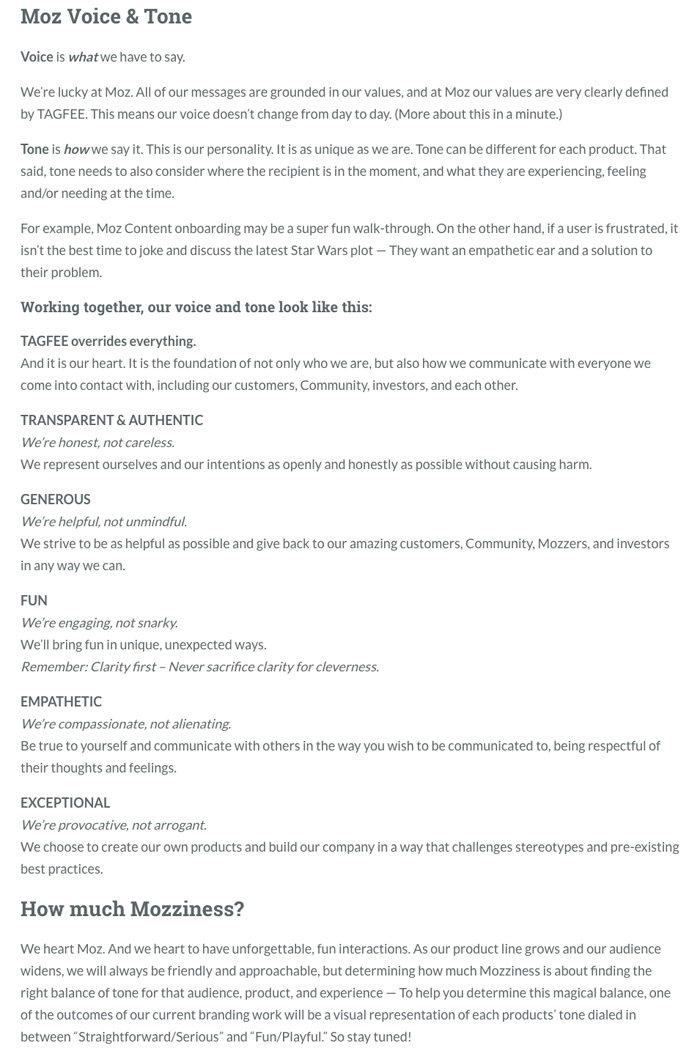
Image via Moz
Related: Personality Matters, Bring Your Brand to Life to Grow Your Profits
In the next example, you can see the MOZ brand tone of voice in action on their Facebook page:
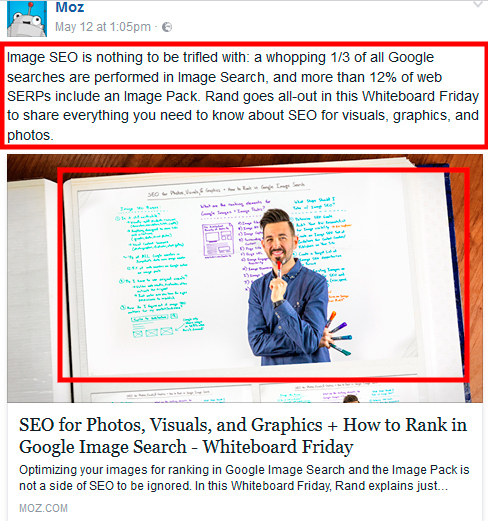
Image via MOZ Facebook page
Each blog post they upload as a Facebook status, includes a helpful summary, and the images they create are customized, fun and eye catching:
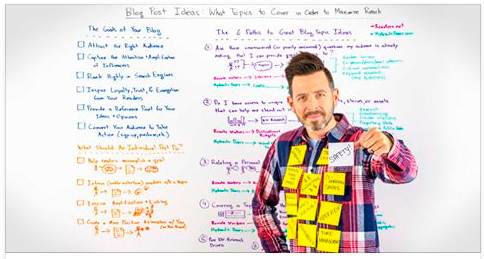
Image via MOZ Facebook page
All the images MOZ uses for their content are specially designed and eye catching, like this one.
No matter how much interaction you currently create on social media, brand tone of voice is essential to convey the right message, to the specific group of people you are targeting — your ideal ‘Purchaser Personas’ — if you want to increase your sales.
Related: Social Branding: The New Rules for Brand Success on Social Media
Summary
Your brand’s tone of voice acts like a magnet to attract the right people, your ideal customers, so you can increase your sales.
To be effective, your brand voice needs to speak to your specific target audience, not to everybody. Words play a huge part in brand personality, and your word style needs to be carefully constructed using brand profiling and then rolled out through the company as part of your brand strategy with absolute consistency. Remember consistency engenders trust and people, customers, only buy from people — brands they know, like and trust.
Your brand tone style guide needs to include social media content and the formulation of responses to messages.
Questions To Consider in Your Brand Tone of Voice
- What is your current tone of voice conveying to customers and prospects?
- What does your tone of voice say about what you stand for and who you are?
- Do you need to re-evaluate your brand tone of voice or perhaps give it a brand refresh?
- Does your tone of voice resonate with the people who matter most; your ideal target customers?

Does your brand tone of voice need a health check? Start your brand audit here.
Related: Rebranding: 15 Do’s and Don’ts for Brand Success
[1] http://styleguide.mailchimp.com/voice-and-tone/
[2] http://www.ritzcarlton.com/
[3] https://www.smartpassiveincome.com/about/
[4] https://ux.moz.com/guides/voice-tone/
Personal Branding: We Are All CEOs (Part 1)
/0 Comments/in Brand Personality, Brand Profiling & Positioning, Personal Branding /by Lorraine CarterIn a two-part post, we take a look at personal branding and why it’s not just for celebrities or VIPs anymore. You can read the second part here
How do others see you in the business arena? What do others think when they hear your name? Your unique personal brand isn’t a collection of past dates, facts, and accomplishments reflected on your CV. It’s your online and offline reputation, it’s how you interact with others, and it’s fundamental to whatever you do every day, whether you’re a student on campus, a globe-trotting CEO, or an office-bound downtown professional.
In short, everyone has a personal brand, whether they like it or not. To get the right personal brand so you can;
- Align yourself more effectively with your corporate brand
- Leverage yourself as an industry leader
- Mitigate risk in your business
- Get paid what you deserve!
- Manage your reputation
- Accelerate your career
- Get headhunted
you must map it out, create it to your liking, develop it and then nurture it.
Tom Peters, co-author of “In Search of Excellence: America’s Best Run Companies,”[1] a landmark business book, provides his thoughts on why we are all CEOs.
Management consultant Tom Peters suggests, “We are CEOSs of our own companies: Me Inc. To be in business today, our most important job is to be head marketer for the brand called You.” – Tom Peters, “The Brand Called You” |
Tom Peters offers tips on building “Brand You” in a series of videos. For his segment on “Brand You: Tell Stories,”[2] watch below.
Related: Brand Stories – 5 Compelling Examples That Sell Themselves (part 1 of 2)
Personal Branding: The Rise of Self
Personal branding is not an overnight task; it requires time and focus upfront as well as ongoing maintenance. Personal branding is not limited to the entrepreneur either — it applies to each and every one of us.
You can be a mini-celebrity within your own industry. CEOs, television presenters, marketing mavens, team sports figures, and popular professors are longstanding examples of individuals who have built personal brands from inside their place of work.
Or, you can create a your own personal brand outside the corporate world.
These days, just about everybody knows someone — if not themselves — who has taken the leap, leaving a more traditional job to turn their side gig passion, talent, or skill into a full-time business. Some are serial entrepreneurs, freelancers, consultants, trainers, writers, artists, musicians, software developers, and yet others are self-employed creatives.
More than 15 million Americans work for themselves and more say they want to.[3] At 15 percent of all workers, self-employment is at an all-time high in Britain, which trails several other European countries, such as Ireland, Portugal, and Italy.[4]
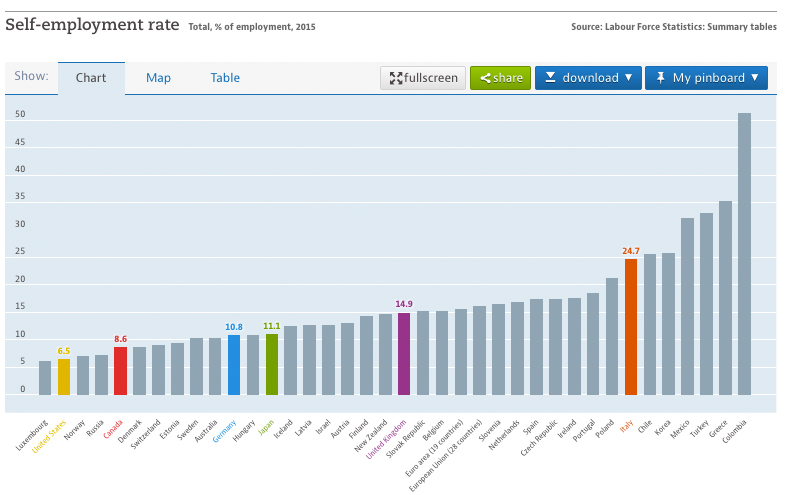
Image: Labour Force Statistics, OECD
As more and more employees step off the corporate ladder for good, the importance of identifying and building a personal brand is paramount. This is exponentially amplified by the internet.
What is Your Personal Brand Profile?
A compelling brand personality that is meaningful and relevant to the people you want to reach is required of an individual in the same way it’s required of a company, product, or service.
Related: Personality Matters, Bring Your Brand to Life to Grow Your Profits
To express your best self in words, try this little exercise from “Personal Branding for Dummies”[5] and watch the Personality Profile Performer™ System video below.
- What three or four keywords describe your essential qualities quickly and clearly?
- What is your essence factor, the core of who you are? “I know I am in my element when __________.”
- What is your authority factor, the knowledge that you hold and the skills that you possess? “People recognize my expertise in _________.”
- What is your superstar factor, the qualities that set you apart? (This factor is how you get things done or what you’re known for.) “People comment on my ability to ___________.”
Foundational principles in branding — brand purpose, positioning, and personality — apply to personal brands as well as to corporate brands, services, and products. Reviewed in context of a personal brand, these core basics are:
Brand Purpose – Defining what you stand for and why you choose to excel in a particular field.
Brand Positioning – Explaining how you stand out from the crowd, your peers and competitors, and how you will execute on that strategy.
Brand Personality – Determining the style and characteristics of how you communicate with others to create an emotional connection.
Related: Personal Branding: The Difference Between Product and Personal Branding
Watch this video from The Onion[6], a news satire media site, to see a spoof about what NEVER happens to those who fail to create a personal brand that stands out.
Related: Personal Branding: We Are All CEOs (Part 2)
Key Steps to Building Your Personal Brand
Map out a branding strategy based on your most important asset: you. Developing a personal brand requires giving thought to your skills, values, passions, and personality. Define how you are unique from your peers and the competition. Identify who you want to reach.
In fact, this exercise is one of the key elements in our brand building programme called the Personality Profile Performer™. As you map out each of your different target audience types — the people you want to be highly visible to, influence and reach — using the ‘Purchaser Personas’ system, the outputs provide the critical insights and direction for how your brand can speak to your primary audience on their terms so they find your message compelling. Winning their hearts and minds on their terms so you can grow your brand and increase your profile. You can watch a free course preview here.

Transform Your Brand – Increase Your Sales with The Personality Profile Performer™ Programme
Now re-evaluate your personal brand. Think about and write down your:
- needs
- core values
- what you stand for – define your purpose
- interests/passions
- vision
- strengths
- weaknesses
- what makes you special – your X factor
- personality
- education / experience
- validation with external feedback (peers, friends)
- positioning statement
- personal brand statement
Alternatively if you want in-person professional direction to build your brand and would like to explore working with us then drop us a line to [email protected] or give us a call T: +353 1 8322724 (GMT hours). We’d be delighted to talk with you.
The Power of Personal Branding
Research shows that when individuals build their personal brands from within an umbrella organization, the business brand(s) to which they’re connected will gain traction as well. Paris-based MSL Group indicates[7] that brand messages:
- Will reach 561 percent more people when shared by employees
- Are shared 24 times more often when distributed by employees
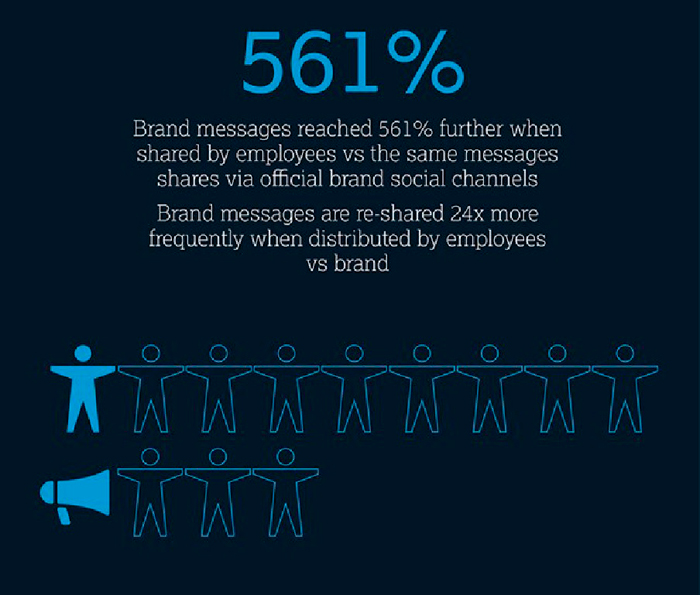
Image: via Scribd, MSL Group
On the entrepreneurial front, Millennial Branding LLC tells YFS Magazine[8], “Your personal brand is transferable from one company to the next and serves as your best protection against business factors you can’t control.”
Top 10 Personal Branding Mistakes to Avoid
Effective personal branding requires dedicated time, proactivity, and professional guidance. Leaving your livelihood to chance or in the hands of others is not an option. Avoid these ten mistakes most frequently made:
- Failing to clarify your purpose
- Tooting your own horn loudly
- Being overly sales-y in any way
- Risking your honesty or authenticity
- Trying to please everyone
- Compromising quality for quantity
- Sloppy networking
- Lack of follow through
- Overlooking your online reputation
- Inconsistencies in what you say, stand for or post online
Related: Personal Branding: We Are All CEOs (Part 2)
4 Personal Branding Case Studies
1. Well-known entrepreneur who created a personal brand
Jamie Oliver started out as a pastry chef who shaped his brand on a healthy school lunch programme. He went on to write one of Britain’s best-selling cookbook, host TV series, endorse Sainsbury’s, multiple food brands and cookware bearing his name, operate restaurants,
win a TedX prize, an MBE, and a place on Britain’s rich list. Watch him tackle the obesity problem in America’s unhealthiest city.
Related: Brand Strategy: 6 Tips for Building Your Profit Growth Plan
2. Relatively unknown, yet a giant in the niche
Ryan is 5 years old. He likes toys. Ryan ToysReview is the world’s #1 YouTube video site. That viewership translates to around $1 million a month in advertising revenue alone.[9]
To read more about how his Mum learned to manage the viral phenomenon of her son’s personal brand, click here.
3. Corporate leader aligned with their personal brand
As Apple CEO, Steve Jobs was one of the most outstanding examples of intertwined and fully aligned personal and corporate branding the world has ever known. With 110% percent of his energy focused on Apple, his signature style on stage and off stage presented as reliably, unwaveringly simple persona, year after year.
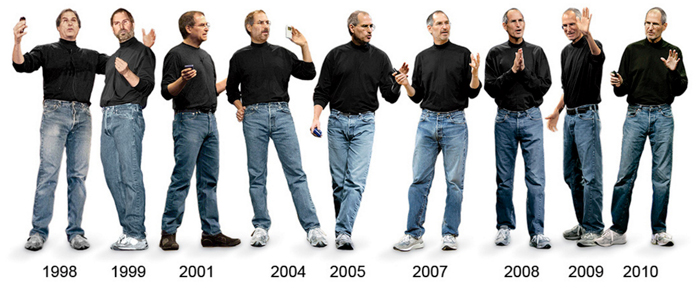
Image via Pinterest
4. SME / SMB personal brand leaders
Laura Madison was selling Toyota cars in Montana so successfully using her own personal brand to promote the business via social media, that she now drives her own brand. Laura surpassed every sales target by promoting herself instead of the car dealership.
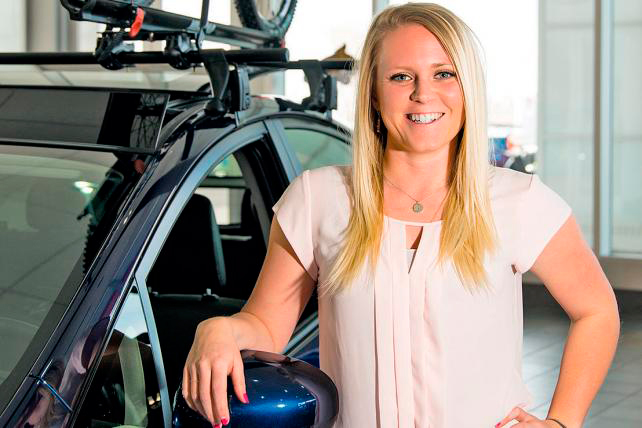
Image via AdAge
Although she saved the company advertising dollars, not every boss would rubber stamp such an approach. However, Laura’s boss says he wished he had 10 more just like her. To find out more about her transition to marketing expert at LauraDrives.com, read her story published in AdAge.
Related: CEO Brand Leadership: How Vision Drives Brand Growth
Ask Yourself These Questions About Your Personal Branding Success
Are you happy with what you find when you Google your own name?
Have you read and acted upon Google’s online reputation advice, seen here?
Have you leveraged all your resources, including networking?
Are you considering a new career direction and, if so, does your online brand presence help or hinder?
How long has it been since you refreshed your personal brand to include a great headshot, elevator pitch and bio?

Build Your Profitable Brand Using The Personality Profile Performer™ Programme with Lorraine Carter
[1] https://www.amazon.com/Search-Excellence-Americas-Best-Run-Companies/dp/0060548789
[2] https://www.youtube.com/watch?v=dH_AqvZJzM0
[3] http://www.pewresearch.org/fact-tank/2016/09/01/8-facts-about-american-workers
[4] https://data.oecd.org/emp/self-employment-rate.htm
[5] http://www.dummies.com/careers/find-a-job/personal-branding/personal-branding-for-dummies-cheat-sheet
[6] http://www.theonion.com/video/company-immediately-calls-job-applicant-upon-seein-31669
[7] https://www.scribd.com/doc/249863818/Infographic-Social-Employee-Advocacy
[8] http://yfsmagazine.com/2012/11/14/expert-reveal-12-personal-branding-tips-for-small-business-owners/3/
[9] https://www.theverge.com/2016/12/22/14031288/ryan-toys-review-biggest-youngest-youtube-star-millions
Use Humour in Branding to Create Strong Emotional Bonds so You Increase Sales
/0 Comments/in Brand Differentiation, Brand Personality, Brand Positioning, Brand Recall, Brand Strategy, Customer Engagement, Humour in Branding /by Lorraine CarterSorting through all the noise we’re bombarded with in the digital era is certainly a challenge. It’s essential for a brand to avoid getting lost in the daily deluge as customers navigate information overload and a visual avalanche to focus on what’s most relevant. That’s where emotional connections come in, solving a digital age dilemma by using humour in branding as the delivery vehicle[1].
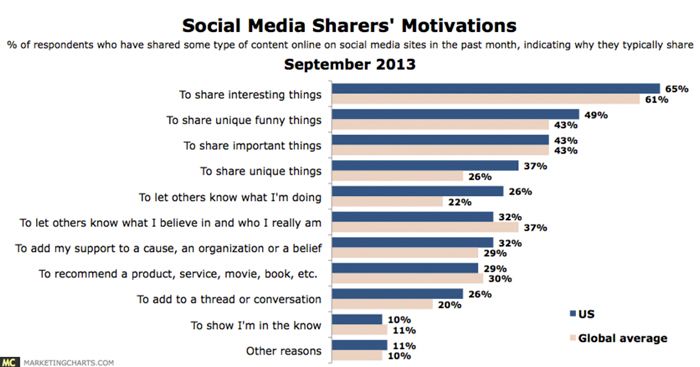
Strong content will stop consumers skipping adverts, according to a study conducted by Millward Brown as reported in Marketing Week[2], which reveals the top five reasons someone will watch. These are:
1) An advert is funny
2) It is for a category the recipient is interested in
3) There is a reward, such as coupon or points
4) The advert is for a brand the consumer is interested in
5) Something noteworthy happens in the first few seconds
Consumer research from Adobe and Edelman Berland indicates that humour is best for product recall according to 7 out of 10 respondents. [3]
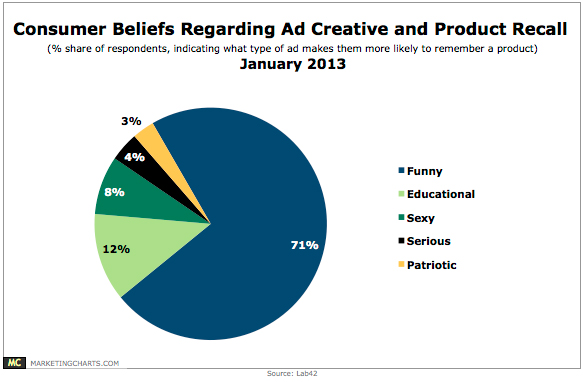
Top Five Benefits of Emotionally Driven Humour in Branding
Research tells us that when customers feel a genuine emotional connection with a particular brand, they generate disproportionate value for that brand. Those who are ‘fully connected’ emotionally are 52% more valuable to brands than customers who are ‘highly satisfied’, reports Harvard Business Review. [4]
Five benefits of emotional branding, especially humour, are:
- Differentiation
- Storytelling
- Personalization
- Relationship
- Loyalty
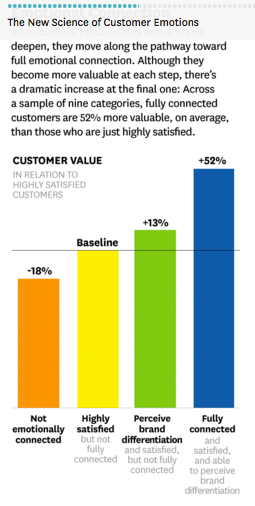
Image via Harvard Business Review
1. Differentiation Through Humour in Branding
Of course, some brands have it easier by their very nature. But it isn’t necessary to be Disney or Ben & Jerry’s to find a deeply personal, possibly humourous, way to present for that all-important emotional bond. Indeed, it’s the all-important way that Disney can differentiate themselves from Universal Studios Hollywood or Legoland and Ben & Jerry’s can inform their strategic direction based on differences from the likes of Häagen Dazs. Humour also amplifies your brand’s personality, giving it more character and life which enables it to standout more strongly and consequently attract your ideal audience.
Read more about how to make your brand standout here: Personality Matters, Bringing Your Brand to Life to Grow Your Profits
2. Storytelling Through Humour in Branding
In the automobile world, for example, it could be a desire to appear flashy, a have a sense of freedom, or the express wish to transport the children safely. Alternatively, Volvo suggests it could be the wish to “Live Fully Now.” While this advertisement’s humour is not the belly laugh type, it’s impossible not to smile as Volvo holds up a mirror to tell the story of each of us (personalization is at work here, as well).
Watch as Volvo evolves from their earlier hard sell and deadly serious car crash commercials emphasizing their steel cage design, to now endeavouring to make a successful emotional connection in the 2017 video,” The Get Away Car,” imploring us to “Live Fully Now.”
Learn how to use storytelling to increase your sales here: Brand Stories, 5 Compelling Examples That Sell Themselves
3. Personalization Through Humour in Branding
Nobody is better at personalization than Amazon, who are acutely aware of any product you search on the web, and quick to pass you pop-up banner ads and emails to let you know that they know. But small brands without the sophisticated big data collection of Amazon can accomplish personalization — with humour — as well.
Read more about delivering customer expectations here: Brand Promises, How to Craft, Articulate and Live Them for Brand Success
Victor Pest makes mousetraps and is a supplier of rodent control supplies — not very sexy as products go. A Victor rodent trap will never make an appropriate birthday or Valentine’s Day purchase, nor anybody’s Christmas wish list.
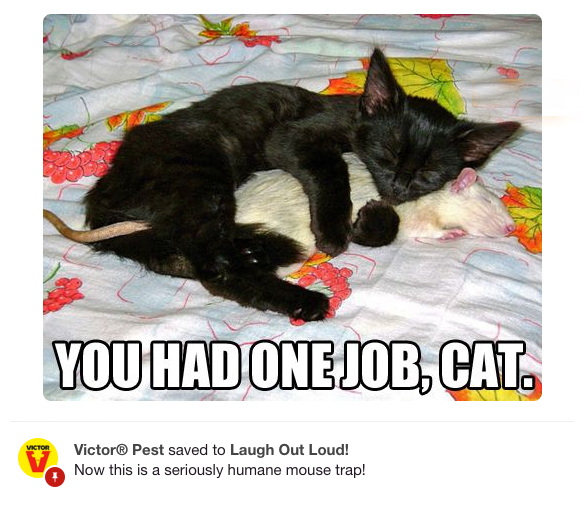
Image via Victor® Pest
They’ve used Twitter and Pinterest as channels for a humorous tone of voice directed at likely customer audiences: home builders, decorators, realtors, property management, home inspectors, exterminators, DIY shop owners, etc. The result goes way beyond what one might expect from a pest repellent company to create top-of-mind-awareness branding for an unsavoury problem.

Join our ‘How to Build Your Brand’ programme here
4. Relationship Building with Humour in Branding
“Hello, I’m a Mac. And I’m a PC” was aired by Apple from 2006 to 2009. What’s the key to this classic ad? Making your own brand the butt of the joke. When you give your brand a frivolous name (Ex: Macintosh, Dunkin’ Donuts, I Can’t Believe It’s Not Butter), it’s a head start.
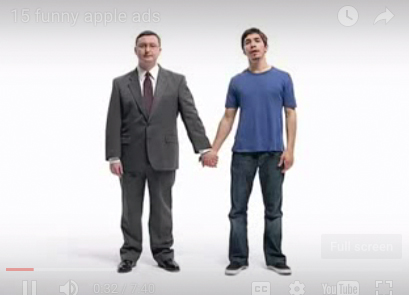
Image via Apple
Building your customer relationships using other types of humorous treatment for your brand include:
- Video commercial. Has there ever been a better example of that first 30-second Old Spice commercial featuring actor Isaiah Mustafa as “The Man Your Man Could Smell Like”? The “wildly smug, cool-cat smooth dude persona” introduced in 2010 maintained eye contact with the camera throughout, creating a connection between audience and Old Spice Man, reaping awards and more than 53 million views by January, 2017.
Old Spice – we have used often, but here it is again because it’s one of the best!
- Print ad. Proving that a picture is worth 1,000 words, Rowenta 2100 Watt Vacuum Cleaner does just that with one image. It connects perfectly with an outdoorsy audience who we imagine must be looking after heritage country estates that require lots of dust busting.
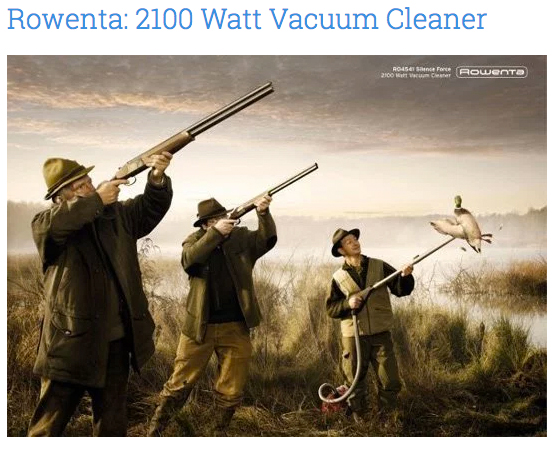
- Jingle and lyrics. “The Meow Mix Theme” was created in 1970 and performed by a dubbed singing cat using subtitles and a bouncing ball on the lyrics. Simple and memorable, “Tastes so good, cats ask for it by name” is considered an advertising classic that cat owners adore.
Learn more about standing out here: How to Use Brand Positioning to Build Brand Impact in an Overcrowded Market
5. Loyalty Created Through Humour in Branding
No matter what size, service, or product, any business can find an emotional connection that creates brand loyalty. Add in a dash of humour for a winning formula with stickiness for loyalty.
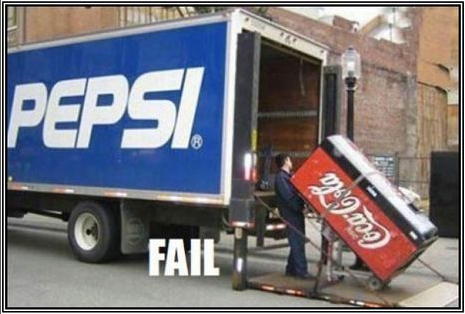
Talk about loyalty…Some of the best-known advertising icons, Poppin’ Fresh Pillsbury Doughboy (1965) and the Morton Salt Girl (1914) are still hard at work through generations of loyal customers.
More than a century later, Morton’s girl is now seen on bus stop shelters to encouraging selfies.
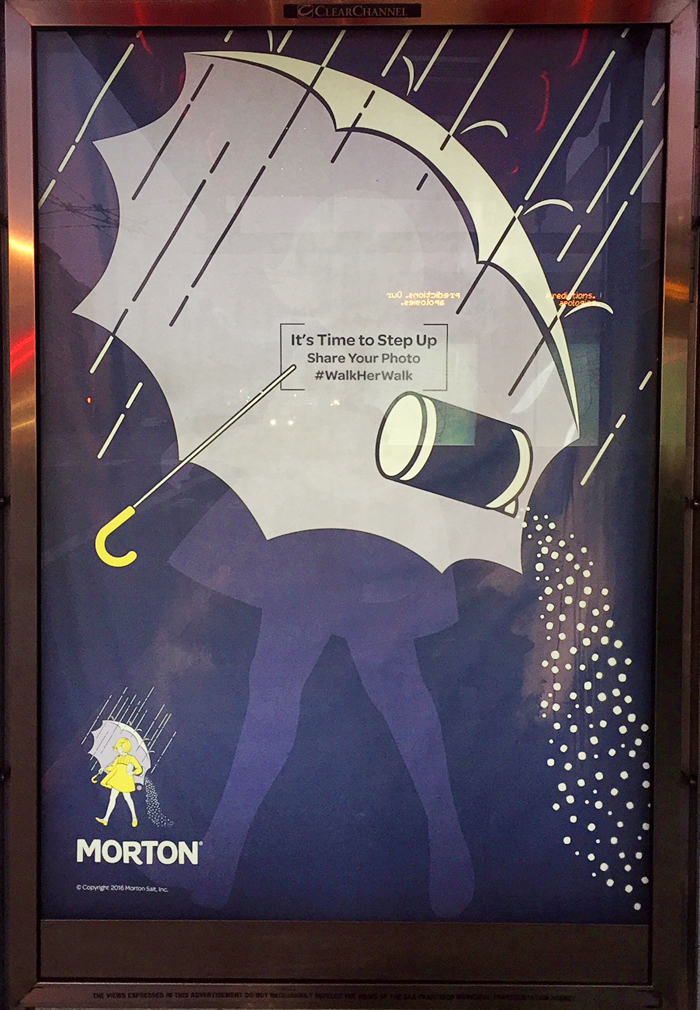
Even a contemporary supply chain software called Kinaxis has found a path for humour, using actors as characters who display their benefits as a service (Simplicity, Flexibility, Easy Upgrades, etc.) in a dating series of videos; have a look.
High tech startup brands don’t expect decades of loyalty in a single ad campaign, but they are looking for swift and sticky traction — translated as loyalty in 21st century lingo.
“Customers define themselves through brands they use. The branded clothes they wear, the cars they drive, the drinks they consume, university they attended, favourite spots to hang out, and so on.”
– Nyimpini Mabunda, Smirnoff Vodka Marketing Manager: “Emotional Branding In a Changing Marketplace”.
Redefine Your Ideal Target Audiences
Remember, there’s a risk with being brilliantly clever and funny. That is, there’s nothing worse than humour that strikes out. To make sure you’re addressing the right humour to an audience to appreciate it, a brand audit is the best way to ensure that your branding reaches the right audience(s). It’s also important to ensure you have your ideal audience fully identified and mapped out in detail. Purchaser Personas or customer pen portraits are an essential tool to ensure you get this right.
“One of the major keys to a successful humorous campaign is variety, once a commercial starts to wear out there’s no saving it without some variation on the concept…while making the customer laugh, they have to keep things interesting, because old jokes die along with their products”.
– Mark Levit, Managing Partner of Partners & Levit Advertising and professor of marketing at New York University.
If you need direction and support giving your brand a health check feel free to get in touch [email protected] or give us a ring T: +353 1 8322724 (GMT hours). Alternatively you can also give your brand a health check yourself to identify its strengths, weakness and areas for potential innovation and growth using our Auditing Analysis Accelerator™ programme. This is a step-by-step walk through, complete with downloads, questionnaires and checklists, to help you audit your brand. You can watch a section of the programme here.

Give your brand a health check here so you become more profitable
Why Humour in Branding Works Best for Sharing and Word-of-Mouth
Your fans and followers on social media provide one of the best ways to get a targeted expanded audience, that is, their friends with look-alike habits, likes, tastes, budgets. When you deliver humorous content, you significantly increase the chances that your fans will share your message.[5]
Don’t Take Your Own Brand Too Seriously
In summary,
- Even mundane products like bathroom tissue, computer hardware, and home owners’ insurance can come to life through the use of humour.
- Bring a smile to their faces — it’s a small gift — it doesn’t have to be a huge guffaw.
- Aim for hearts over wallets, the heads will follow — remember you must move the heart first if you want to win the mind
“When a brand shows that it doesn’t always take itself too seriously, it’s a powerful way to demonstrate authenticity and confidence, as well as connect with your community.”
– Tim Washer, standup comedian, Webby-nominated video producer and corporate humorist; creator of Cisco’s “The Perfect Gift for Valentine’s Day” video for the $80,000 ASR 9000 router.
Here’s one of our all-time favorites from Blendtec to inspire you to think outside the box when creating humorous content.
Questions for Brand Owners, Managers and Entrepreneurs About Using Humour in Branding
1. Does your brand lend itself to humour across customers, staff, and stakeholders?
2. How well do you know your customer base? When did you last conduct a brand audit of your customers?
3. Have you clearly identified your prime target audiences beyond your immediate base? Have you mapped out your different customer types with your Purchaser Personas™ so you can attract your ideal audience more effectively?
4. When was the last time you conducted a comprehensive health check of your brand?
5. Will a tasteful, humorous approach fit with your brand promise and your audience(s)?
Want to make your brand more successful or launch a new one? Find out how you can here.
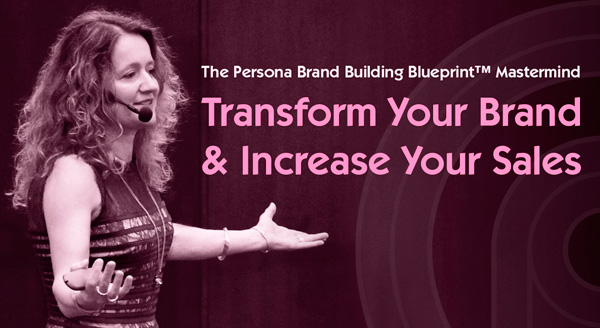
Build your winning brand with The Persona Brand Building Blueprint™ Mastermind here
[1] http://www.marketingcharts.com/online/americans-more-likely-to-share-funny-than-important-content-on-social-media-36502
[2] https://www.marketingweek.com/2016/02/21/good-old-fashioned-advertising-creates-loyal-customers/?nocache=true&adfesuccess=1
[3] http://www.marketingcharts.com/traditional/7-in-10-consumers-believe-funny-ads-spur-better-product-recall-25911
[4] https://hbr.org/2015/11/the-new-science-of-customer-emotions
[5] http://www.marketingcharts.com/online/americans-more-likely-to-share-funny-than-important-content-on-social-media-36502
Family Business Branding and The Secret Drivers to Brand Success
/0 Comments/in Brand Personality, Brand Relevance, Brand Reputation, Brand Strategy, Brand Values, Customer Engagement, Entrepreneur, Family Branding /by Lorraine CarterAt his Tuscan estate overlooking Siena, Dr. Francesco Mazzei pours a glass of ruby red Chianti Classico while beginning to tell the story behind the distinctive label that represents several legacies: the name of his family’s medieval country house castle, the village hamlet, the family winery, and the year it was founded. “Castello Fonterutoli Mazzei 1435” wine is one of the acclaimed reds the Mazzei family has been producing for a remarkable 24 generations; in fact, in terms of family business branding, they’re one of the ten oldest family enterprises in Italy. Naturally, wine lovers are intrigued to hear more from the charismatic Marchesi Mazzei and eager to taste his time-honoured Chianti.
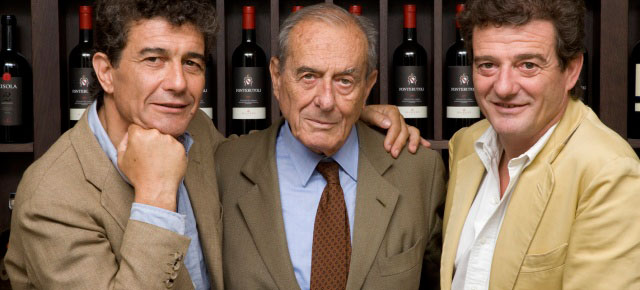
Image via Mazzei
Family Business Brands Drive the Economy
Family-owned and operated businesses come in all shapes, sizes, and ages. Yet they share the roots of a common attribute: quintessential authenticity. A family business brand has a distinctly personal voice and can uniquely build unparalleled trust. Trust underpins profitable brand growth because without trust customers won’t buy from you.
It’s critical to understand, whether your business is a family enterprise or not, branding is NOT marketing or design but the bedrock strategy supporting and directing your whole business so your brand strategy is fundamental to your business’s longevity and ongoing profitability.
Global management consultancies are wise to keep a keen eye on family enterprises. EY suggests that family business is the world economy’s “secret driver of success.” Their research library published a 2015 report undertaken with Kennesaw State University Cox Family Enterprise Center (Georgia, USA) indicating that: “The importance of family businesses to the global economy is undeniable. They account for more than two-thirds of all companies around the world, many of which are household brand names, and 50%–80% of employment in most countries.”[1]
At the KPMG Family Business Practice Global Think Tank, the group’s CEO for France explains, “It’s a philosophy, it’s a spirit, it’s a backbone of our economy.” [2]
“Before the multinational corporation, there was family business. Before the Industrial Revolution, there was family business. Before the enlightenment of Greece and the empire of Rome, there was family business.” – William T. O’Hara, author, “Centuries of Success |
We’re all busy so building the bedrock brand strategy supporting and directing your whole business to ensure it’s growth and sustained longevity may not be your top skillset. If you’d like professional branding input and want access to a detailed overview of what’s key in the brand strategy context to grow your business then get in touch? Alternatively book one of our transformational workshops, brand building intensives or masterclasses.
The Persona Brand Building Blueprint™ Mastermind empowers you to build your brand strategy, raise the visibility of your brand, reduce customer acquisition costs and position your brand as the №1 choice for your customers.

Build your standout brand at the Persona Brand Building Blueprint™ Mastermind with Lorraine Carter
Family Business Branding Has a Lasting Brand Message
“From our family to yours…” is a strong, positive, relatable and emotive message. Family businesses are proud of their companies and their families, with 76 percent of those reporting in the EY study saying they refer to themselves as a family business in advertising, websites, social media, press releases and other promotional material and brand collateral. [3]
Related: Design Is NOT Branding: 10 Things Every Business Owner and Entrepreneur Should Know
Nothing is more enduring as a family business than two hospitality examples from Japan. Zengoro Hoshi is the 46th generation boss of The Hoshi Ryokan, a traditional Japanese inn established 1,300 years ago.

Image via 663 Highland (Wikimedia CC 2.0)
The world’s oldest hotel is run by Fujiwara Mahito, the 52nd generation descendant to manage Nishiyama Onsen Keiunkan since the year 705, beside hot springs where travelling samurai and Shogun once stopped to refresh.[4] In an interview with the KPMG Family Business Think Tank, Hoshi explains that both the family and the business core values are seamlessly expressed and impressed, “instilling the simple business motto in each new generation.”[5]
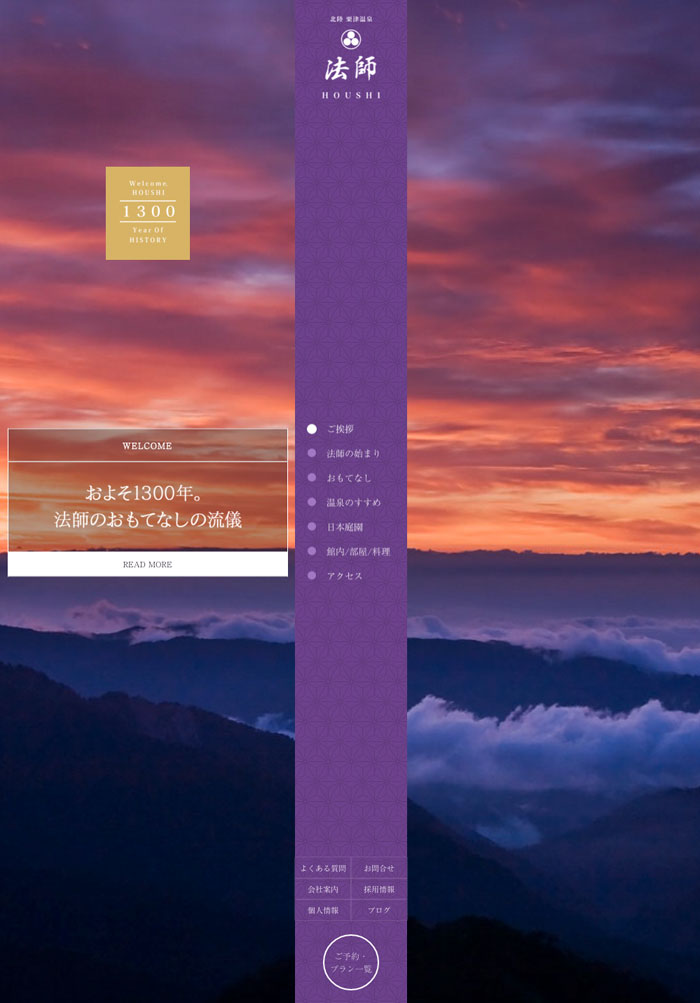
Related: 7 Powerful Components Of A Lasting Luxury Brand
When success breeds success and astronomical growth and wealth occur rapidly in the span of one lifetime, keeping customers connected to core brand values is a strong message that the founder can embrace and project. Two powerful examples of self-made 20th-century patriarchs are seen here:
Family Business Branding Through Their Founders Can Embody Authentic Brand Values
1) IKEA – From humble beginnings, one of the world’s wealthiest individuals is the 90-year-old founder of the largest furniture store group on earth, as well as the second-largest charitable foundation. He eschews the trappings of wealth, living in his boyhood rural Älmhult municipality, where IKEA headquarters is located.
Related: Social Responsibility: How to Build a Socially Conscious Brand
As a boy, Ingvar Kamprad bought matches in bulk from Stockholm to re-sell via bicycle in the vicinity of his parents’ farm, Elmtaryd, in the small Swedish village of Agunnaryd. As a teenager, Ingvar expanded into seeds, pencils, wooden Christmas decorations and more items. Working at the kitchen table, he named his little enterprise IKEA, combining his own initials plus the farm name and the village name.
In the autobiographical “Leading by Design: The IKEA Story,” and in the resource “Ikea Bible,” founder Kamprad has emphasized that “wasting resources is a mortal sin at Ikea.”[6] In his years at the helm of the budget-focused retailer, now run by his son, Kamprad pursued management by example, that is, emphasizing cost control. He has spoken of shopping post-season sales, flying economy class, driving a 20-year-old Volvo and encouraging staff to use both sides on a piece of paper.[7]
2) Berkshire Hathaway – Another farm kitchen table entrepreneur empowered by his bicycle, a young Warren Buffett sold chewing gum, Coca-Cola bottles, and weekly magazines door-to-door in his native Omaha, Nebraska.
Ever thrifty at age 86, Buffett is currently ranked as the world’s third wealthiest person[8], the legendary investor is grounded and approachable. He pays himself a modest salary of $100,000 annually and still lives in the Omaha home he purchased for $31,500 in 1958.
A voracious reader, Buffett practices his brand philosophy, frequently sharing advice with groups of college students to remind them that the best thing they can do is develop good qualities and habits early.[9]
Family Business Branding Creates Meaningful Brand Differentiation
Nobody can weave a more engaging, authentic brand story than a family business, and this is key to one of a brand’s eight pillars: differentiation. The perceived distinctiveness of the brand instantly separates a family brand from its competition. These brand pillars are fundamental to success regardless of your brand sector, B2B or B2C — which has also been abundantly evidenced by our experience in working with small and large family businesses nationally and internationally.
Related: 4 Reasons Why Your Business Profit Starts With Your Brand Mission
How did a first-generation pioneer build a company from nothing to pass on to the next generation? What was the initial spark of an idea? These are the stories that inspire pride and loyalty among employees, customers, suppliers and the local community. Such wonderfully curated (and honest!) anecdotes can be as juicy and delicious as your grandmother’s time-honoured recipe for apple pie.
If birthright or marriage has made you lucky enough to inherit a family brand, or if you aspire to achieve a highly recognisable, memorable — and loved — brand name, our Personality Profile Performer™ Programme shows you how to build your brand so you become, or maintain number one place in your market — how to enhance your brand relevance and improve your profits.
Also, times flies and we are aware that family businesses must be astute about strengthening, re-evaluating and leveraging brand relevance while training and managing succession and growth over the next 5, 10, 15-plus years. If you want in-person professional direction to re-evaluate your brand and would like professional input then drop us a line to [email protected] or give us a call T: +353 1 8322724 (GMT). We’d be delighted to talk with you.
Examples of Intimate Brands in SMB/SME Family Business Branding
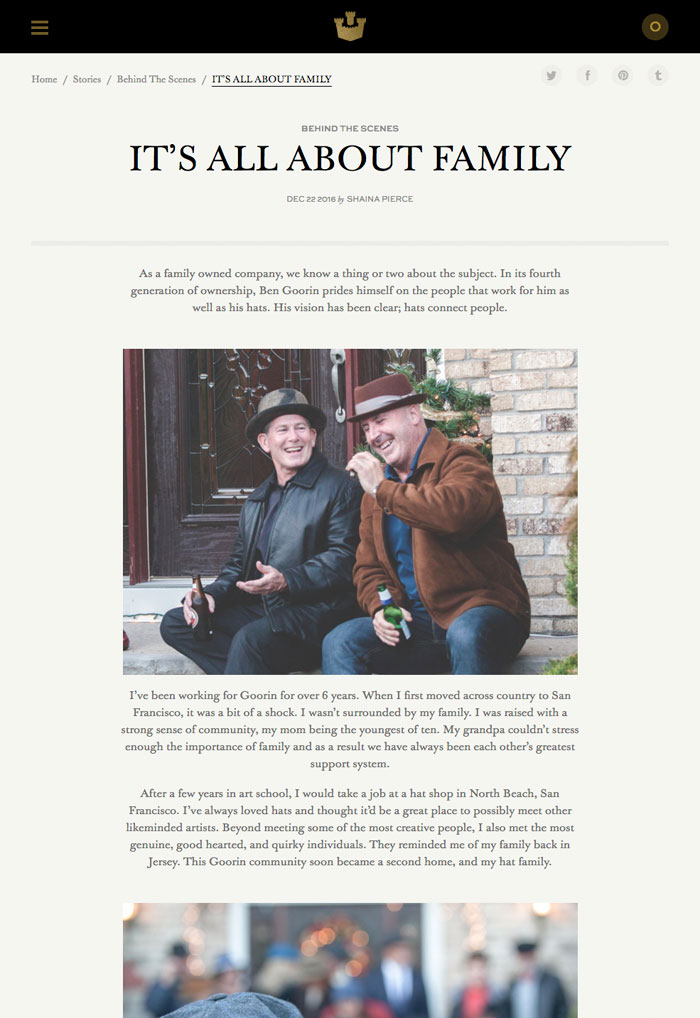
Image via Goorin Bros. Hatmakers
What We Love: Vintage sepia tones and modern fashion shots merge on this American hatmakers’ website. It’s sprinkled with historical anecdotes, providing interesting insights into the family brand established in 1895 (I know anything over a century is almost ancient, by American standards!) Goorin Bros. is painfully aware that hats are no longer the mandatory accessory they once were. The website relates the compelling story of brand survival and interprets the castle logo design.
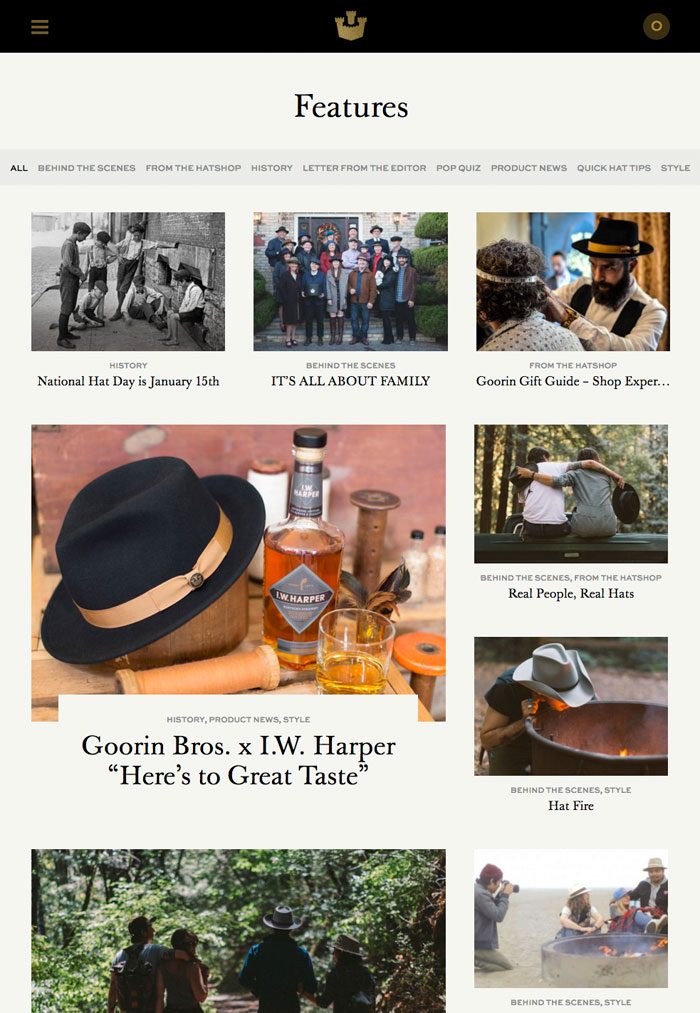
Image via Goorin Bros. Hatmakers
Takeaway: Cosy store interiors are decorated in vintage style, including an antique popcorn machine spitting out free samples, with highly personal assistance from the well-trained hat sellers.
Related: The Impact of Company Brand Culture On Driving Performance and Increasing Sales
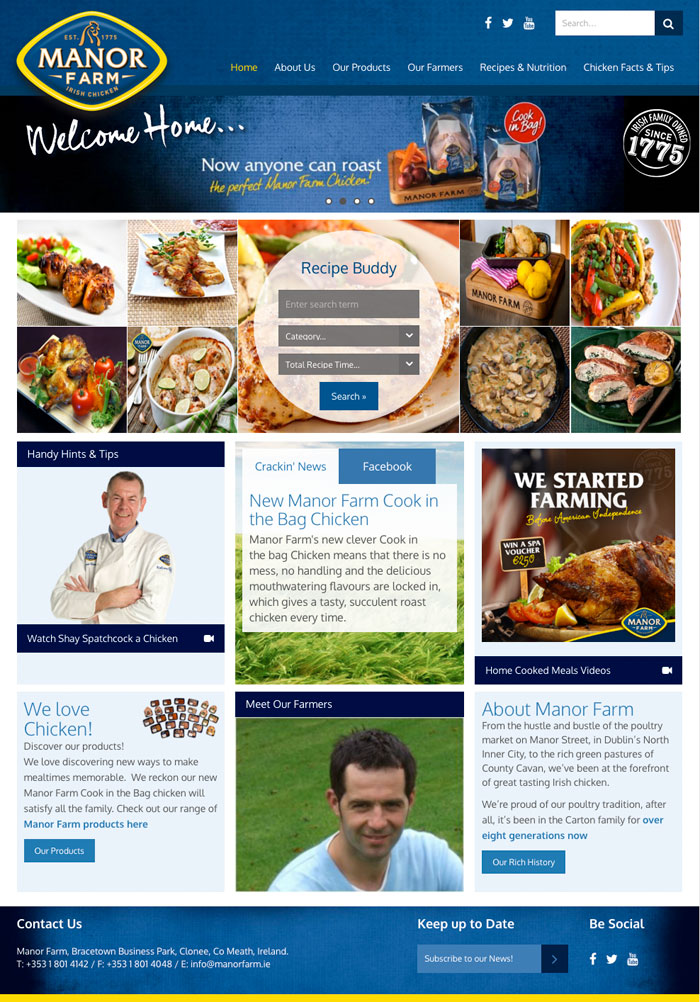
Image via Manor Farm
What We Love: More than 240 years later, one of Ireland’s oldest companies remains a family business. To establish an immediately personal connection to the brand, the website’s “Welcome Home” page features a seal of approval-style stamp reading “Irish Family Owned Since 1775.” It invites visitors for a glimpse behind the scenes to “Meet the Flock” of family farmer suppliers via their outdoor snapshots and to share the “Tasty News” recipe buddy.
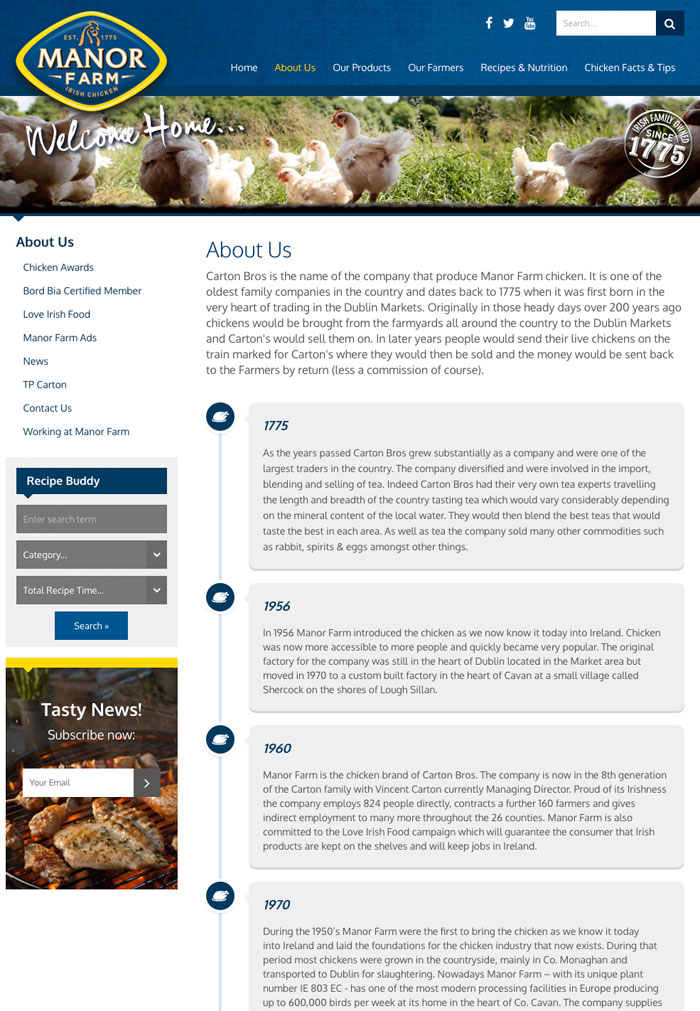
Image via Manor Farm
Takeaway: Manor Farms engages their B2B and B2C audiences by using humour. Chicken Facts & Tips includes Q&A such as “Are the chickens really Irish?” and “Can a chicken fly?”
Related: From Zero to Hero: How to Become a Must-Have Brand
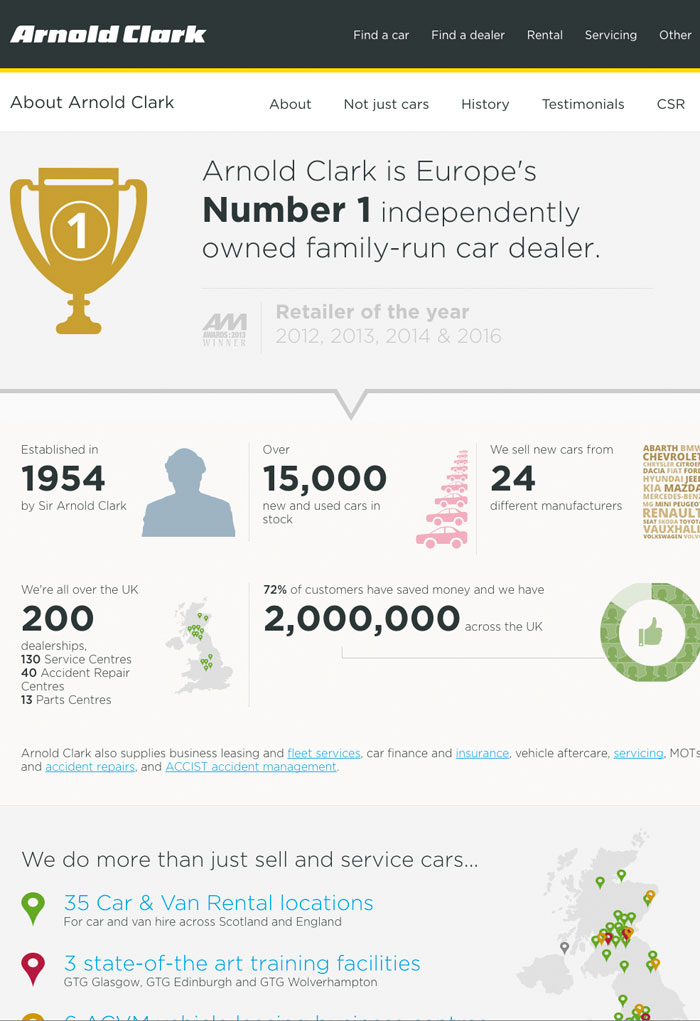
Image via Arnold Clark
What We Love: In 1954, Arnold Clark purchased a Morris Ten Four for £70 and, after many careful hours restoring the car to its original condition, sold it for a profit. The brand’s storyline is front and centre on the website where Arnold Clark proclaims itself “Europe’s Number 1 independently owned family-run car dealer.” One of Scotland’s largest companies, the family-owned firm run by its founder, whose story is a centrepiece for the brand. Sir Arnold is still in charge and has been joined in the business by his children and grandchildren.
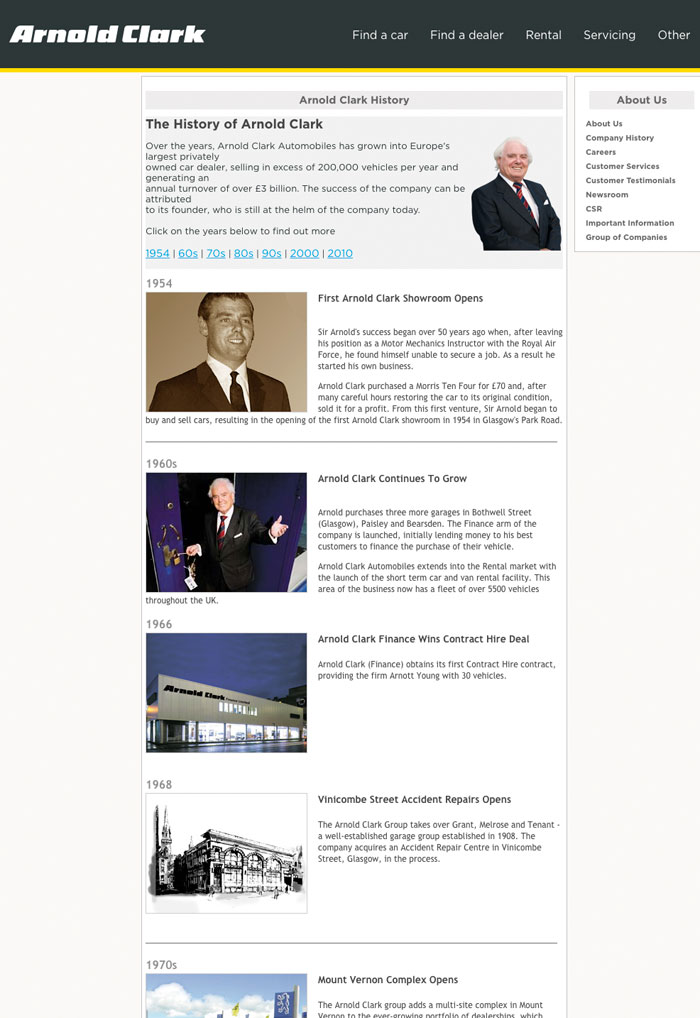
Image via Arnold Clark
Takeaway: The Arnold Clark testimonial page tells the story in the customers’ own words and leaves no room whatsoever for anything but strong assurances about the brand’s commitment to integrity.
Related: How to Develop Your Brand Tone of Voice to Increase Sales
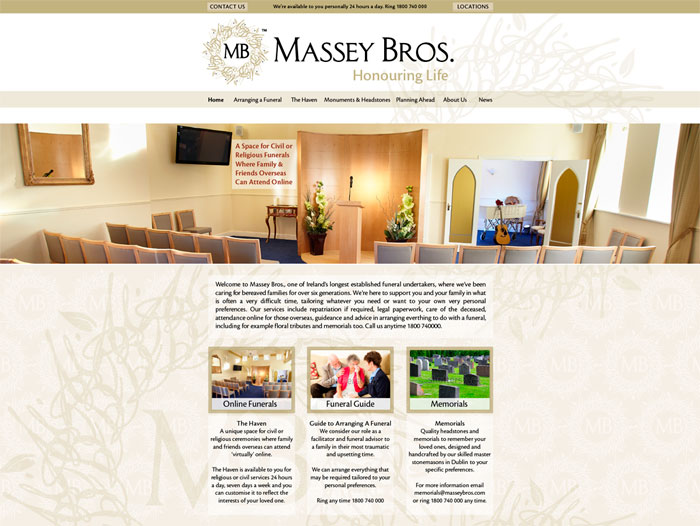
What We Love: Massey Bros. provide a really important service in one of the oldest services in society. They take care of you and your family in very distressing circumstances, the death of a loved one. They deal with death on a daily basis throughout the year. And yet their mission in dealing with death every day is to do whatever it takes to make the recognition and memory of your loved really special. Their mission is to Honour the Life of your loved one.
Massey Bros. is a business that can’t market itself like most others, they can’t overtly sell what they do, but they can share why they do what they do. Their purpose it what drives their big why and it’s one of the critical secrets to their success since the 1930s.
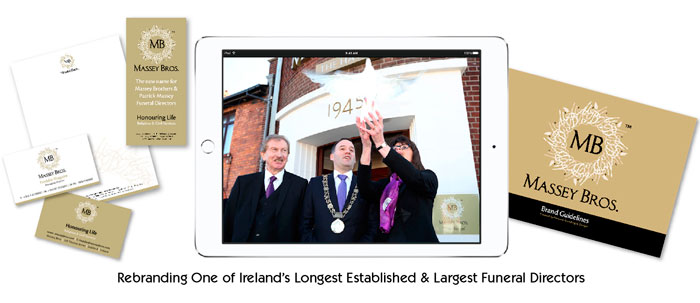
Takeaway: Testimonials that support the brand promise are featured throughout the website, which makes all the sense in the world in any business, especially one that requires utter all-encompassing care and total discretion.
Full disclosure: Persona Design worked with Massey Bros. on their brand revitalisation. You can read the case study here. In truth, haven’t worked with any other business which gets the amount of unsolicited thank you cards and letters that Massey Bros. get. They truly live their brand mission, like many other successful and very dedicated family businesses.
What We Love: The Sonderen tagline, “Packaging Solutions That Create Lifelong Customer Relationships” gets to the core of this family-owned B2B operation where we meet the second and third generation Mark, Matt, and Keva Sonderen, “Trusted Since 1963.” A complete folding carton manufacturer in Spokane, Washington USA, they do everything custom from design to finish, including inks, hard surface coatings, and die cut options.
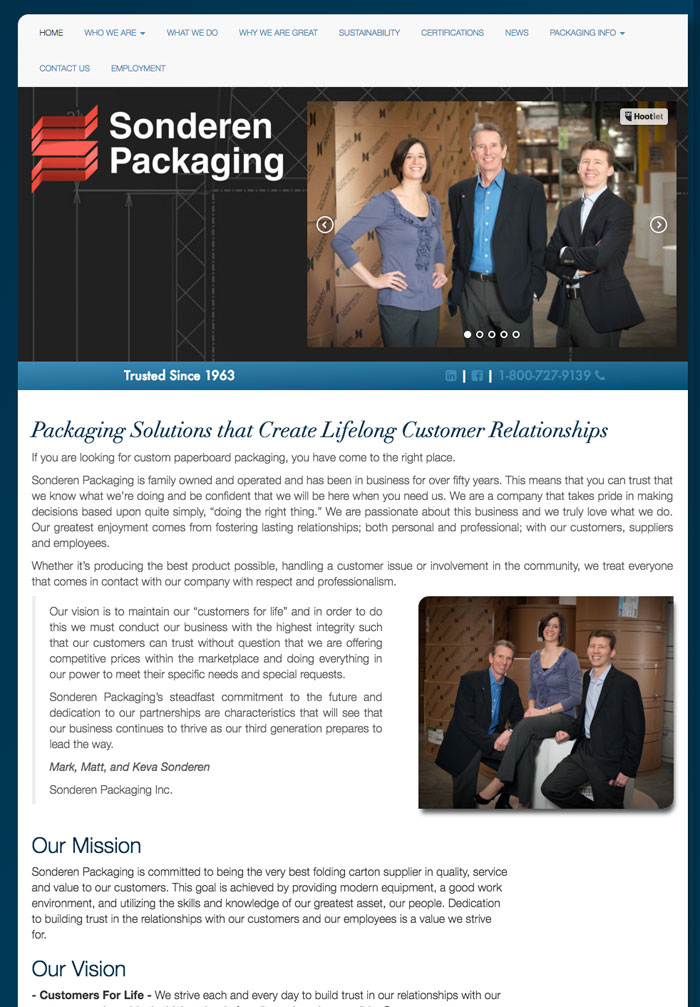
Image via Sonderen Packaging
Takeaway: A video, “Want to Learn More About Who We Are” presents the passion behind the business, its growth from 8 to 140 employees and its recovery from a devastating warehouse fire to achieve a customer retention rate above 95 percent.
Questions to Ask Yourself About Your Family Business Branding
- Have you identified your eight brand pillars and evaluated how they’re addressed from the customers and team internal perspective? These include elements such as your brand purpose, vision, values and personality.
- Have you developed passionate storytelling about your brand involving personal bits and pieces about family members that pertain to building the company and have those authentic story nuggets been shared congruently across all your brand touchpoints?
- Have you fully developed your standout brand messaging with its own unique personality, copywriting, language style and turn of phrase? Does your family business take full advantage of its brand messaging opportunities across all relevant brand collateral and media channels on and offline?
- Have you developed and displayed a proud history timeline in the proper tone of voice to suit your brand?
- Is there a cohesive branding message and visual language across every customer touchpoint, from website to logo, from uniforms, to colour palette and packaging, for example?
- Has the company story been shared with employees? Is it featured in all new hire training materials? Have your team been fully brand inducted and is ongoing training a part of your brand culture for ensuring cohesiveness, strong morale, innovation, growth and longevity?
[1] Global Data Points; Family Enterprise Statistics from around the World, Family Firm Institute, www.ffi.org/?page=GlobalDataPoints
[2] http://www.kpmgfamilybusiness.com/family-business-contributors
[3] http://www.ey.com/us/en/newsroom/news-releases/news-ey-family-business-is-the-world-economys-secret-driver-of-success
[4] http://www.atlasobscura.com/places/nishiyama-onsen-keiunkan
[5] http://www.kpmgfamilybusiness.com/worlds-oldest-family-inns-secret-succession
[6] http://www.forbes.com/profile/ingvar-kamprad
[7] Ibid.
[8] http://www.forbes.com/profile/warren-buffett
[9] http://www.forbes.com/sites/patbrans/2017/01/02/what-warren-buffett-and-ann-graybiel-advise-on-habits/#422723085d95
Personality Matters: Bringing Your Brand to Life to Grow Profits
/0 Comments/in Brand Personality, Brand Profiling & Positioning, Brand Voice /by Lorraine CarterBreathe life into your brand. Like people, strong successful brands are alive; they have a distinct voice, individualistic traits, characteristics, and personalities. Brands must continually grow and evolve to stay relevant, or die. As with people, the development and reinforcement of that personality creates a unique persona and serves to differentiate your brand from the others, particularly the competition.
David Ogilvy, the “The Father of Advertising,” who is credited with having introduced the concept of brand personality in 1955, is widely quoted as saying, “Products, like people, have personalities, and they can make or break them in the marketplace.”
Where does this brand personality come from? It is crafted and nurtured by the stewards of the brand: owners, stakeholders, managers, employees, and customers. In an important research paper titled “Dimensions of Brand Personality (1997),” Stanford University Professor Jennifer Aaker discusses the main human characteristics associated with brands.[1] In fact, she argues, the connections can be so strong that, “the personality traits of the people associated with a brand are directly transferred to the brand.”
These traits can include gender, age, and more demographics. We could hardly think of Disney without conjuring up the image of a cheerful, adventurous Mickey Mouse and his girlfriend, Minnie.
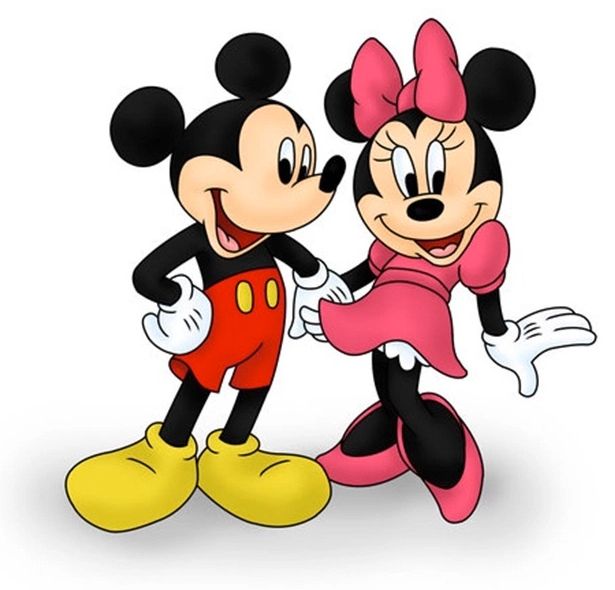
Image via Disney
There’s a reason why we’re not conditioned to think of effervescent Coca-Cola as the beverage of retired librarians in a bingo hall. And, since the “Sticky Fingers” album launch in 1971, nobody has wondered whether the hot red lips image is about bad boy Mick Jagger and The Rolling Stones.
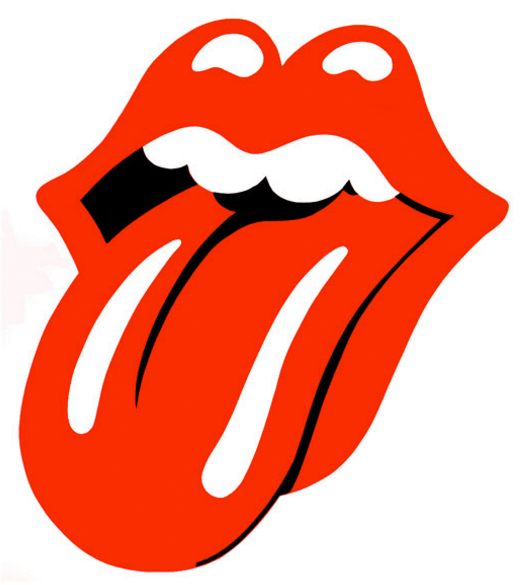
Image via Rolling Stones, YouTube
Identify the Right Audience
Some brand target audiences are easier to identify and to target appropriately. Kids who fancy a burger and fries with a milkshake relate to those Happy Meal toys from Ronald McDonald, the clown. Of course, the hamburger chain wants to appeal to parents as well, so McDonald’s will provide nutrition facts for popular menu items.
“Hop in the car, kids!” Adults relate to driving the children to McDonald’s in a car such as Volvo, because that family automobile brand is all about safety.
The skills and insight that go into correctly identifying your primary target audience, and mapping out each of those customer types through their ‘Purchaser Personas’, means that your brand can tap into their attitudes and values to build a simple, strong compelling message in language that they find irresistible.
On the other hand, you can’t attract the attention of your ideal audience and sustain their interest if you don’t know them intimately — their needs, wants, loves, hates and aspirations. It’s obvious that putting the right image in front of the wrong audience ensures either an unsuccessful connection or none at all.
Getting it right creates the magnetism that becomes a really important part of successful brand building. It’s one of the critical tools used for mapping out your different customer types, also known as Purchaser Personas.
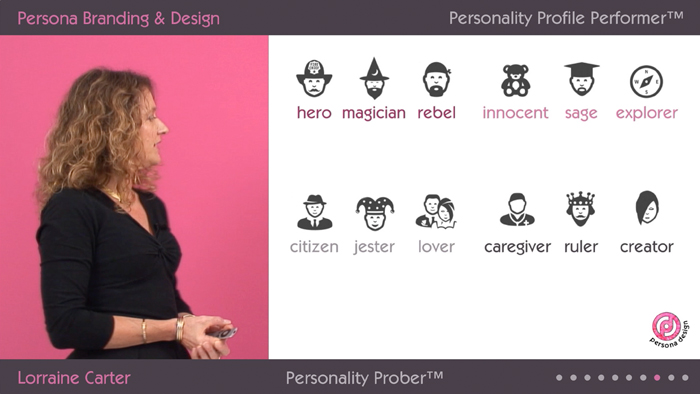
Build Your Winning Brand Personality with The Personality Profile Performer™ Programme – Watch Your Programme Preview Here
Appeal to the Right Audiences
In fact, this exercise is one of the key elements in our brand building programme called the Personality Profile Performer™. Every business has a minimum of two and up to twenty different customer ‘Purchaser Personas’ which provide the critical insights and direction for how your brand can speak to your customers — winning their hearts and minds on their terms — so you can grow your business. You can watch a free course preview here.
Alternatively if you want in-person professional direction to build your brand and would like to explore working with us then drop us a line to [email protected] or give us a call T: +353 1 8322724 (GMT). We’d be delighted to talk with you.
A Perfect Match
Why is brand personality so critical? The personality of a brand determines the relationship a consumer has with the brand. When that connection is an emotional one, it drives purchase. “The aim of marketing is to know and understand the customer so well the product or service fits him or her and sells itself,” according to “The Father of Modern Management,” Peter F. Druker.[2]
The Brand Personified
So, do I need a Mickey Mouse or a Jolly Green Giant to infuse my brand with personality? No. Assigning personality to one’s brand should not be confused with creating a mascot or partnering with a celebrity to endorse the brand. Both are acceptable, but neither is required.
Keep in mind that people tend to anthropomorphize; that is, they transfer human personality characteristics to inanimate objects. We do it all the time, even when speaking of diverse items: destinations, fragrances, residential properties, boats and ships referred to as ‘she.’.
Professor Aaker charts the five major brand personality dimensions and fifteen facets as follows:
Examples: We can match several global brands with their relevant personality types to demonstrate the concept.
- Sincerity = Nike, Disney, Cadbury’s, Tropicana
- Excitement = Coca-Cola, Airbnb, Victoria’s Secret
- Competence = Volvo, Apple, Amazon, Timberland, Intel
- Sophistication = Chanel, Dos Equis, BMW, Tiffany, Cartier
- Ruggedness = Patagonia, Old Spice, Jeep, Harley Davidson
Finding Your Brand Voice for Your SME / SMB Business
For startups, small to medium-sized businesses, finding or re-evaluating your brand voice is a very important process, I’d even go as far a saying is critical to your brand success. SMEs often begin by brainstorming some of the options in a simple YES-NO process to explore whether their brand is, for example:
- Formal or funny?
- Masculine or feminine?
- Adventurous or tame?
- Young or mature?
- High tech or traditional?
- Trendy or classic?
- Accessible or exclusive?
- Premium or inexpensive?
Four diverse examples of SME / SMB brands with strong brand personalities that ensure they standout and attract their ideal customers include:
We love it: Fashion Award Cleaners
Why it works: A dry cleaner with glam personality? Why not? You’ll notice straight away that owner Debra Kravet has infused personality into “Talk of the Gown,” a 50-year-old family business that is anything but fuddy-duddy. As animated models strut across the virtual Manhattan runway of Debra’s website, any fashionista with a special garment or clothing repair requirement will quickly realize that this miracle cleaner with attitude is likely worth a trip across town, even in rush hour.
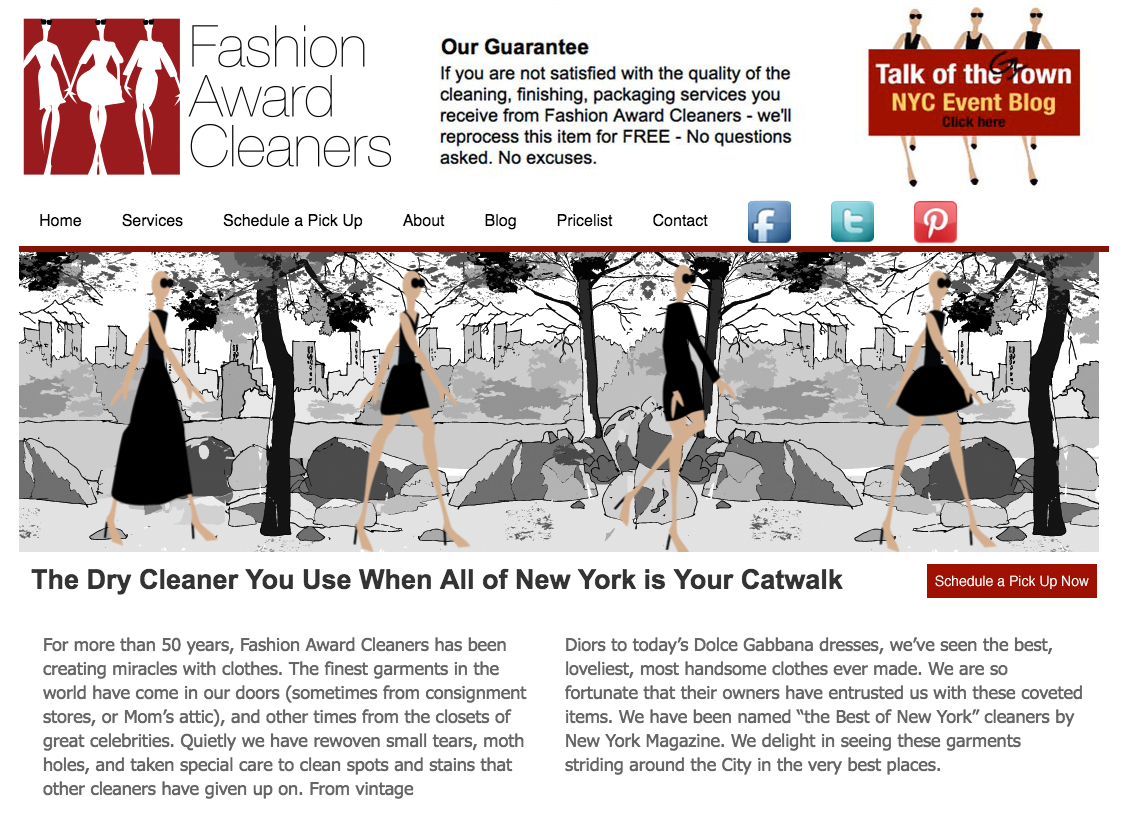
We love it: Daylesford
Why it works: Founder Carole Bamford’s personal holistic lifestyle is imprinted all over the Daylesford brand in an appealing, authentic one-to-one tone of voice. This Gloucestershire organic farm knows there are other brands you can reach for on the grocer’s shelf; however they take care to present the philosophy behind 35 years of leadership in the farm-to-table approach. “If you understand the story of the Daylesford Pedigree British Friesian dairy cow, you will understand the philosophy that drives Daylesford,” they suggest. You do feel as though you’re being let in on a secret.
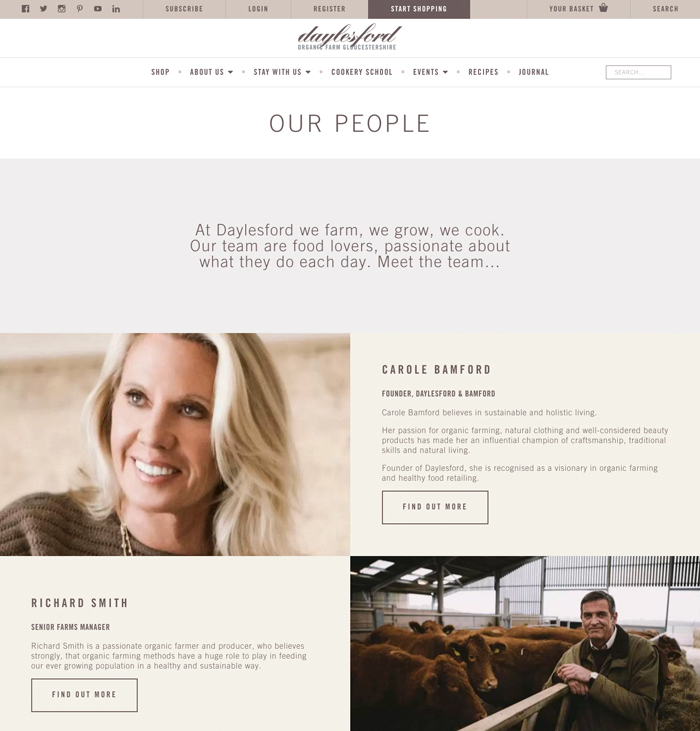
We love it: Seedlip
Why it works: Presenting the world’s first non-alcoholic spirits. The brand story starts out, “Founded by Ben in his kitchen in the woods with a copper still and copy of The Art of Distillation to to continue his family’s 300 year farming ancestry and change the way the world drinks.” We already want to know more, how about you? Next, we meet Ben, discussing a legacy that dates back to 1651. Seedlip’s intriguing personality is equally natural, historically grounded, and innovative at once. Above all, hand-crafted shines through.
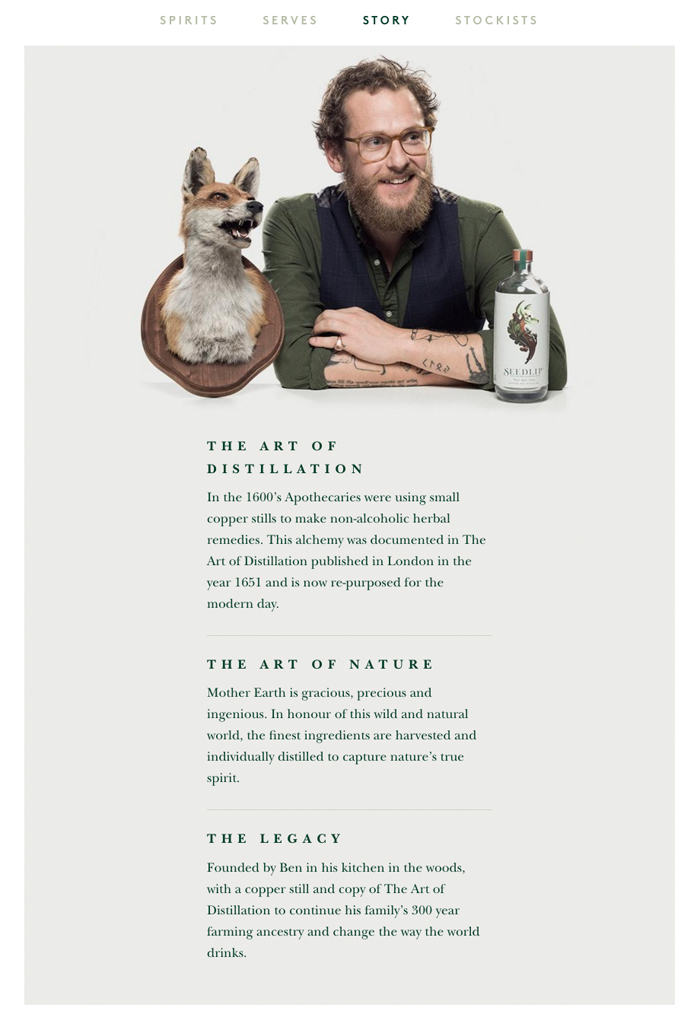
We love it: Hampton Creek
Why it works: Can you truly love a condiment? Just Mayo was the original Hampton Creek product in 2011. This plant-based food company that doesn’t use eggs started out small with strong personality, capitalizing on the “JUST” branding for expanding the line. Investors were attracted to the R&D, vegans were attracted to the solution. A visit to the company’s social media sites reveals the friendly, trusted voice of the brand through shared recipes that produce love — a strong emotion — from customers. Annual revenue is now estimated at $30 million-plus and with 110 employees[3].
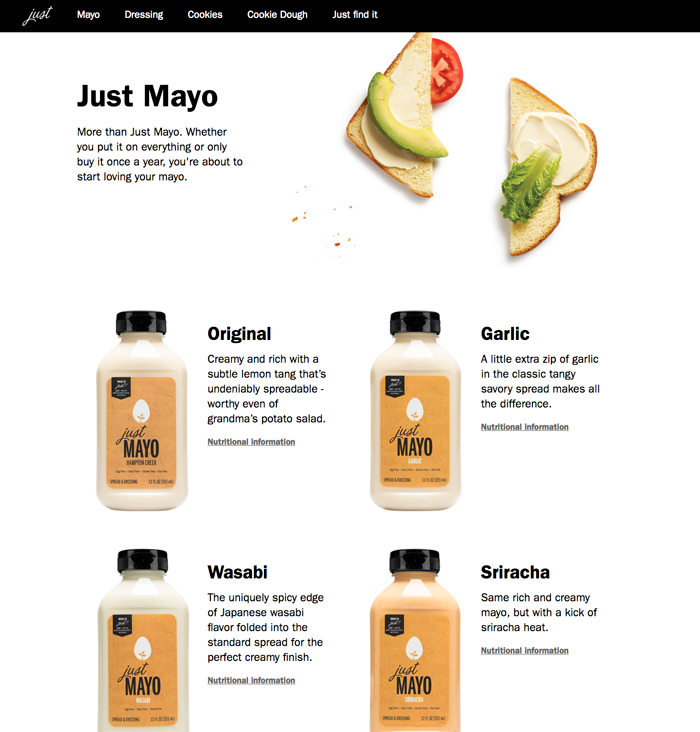
Branding Initiatives Can Start Out Small
While SMEs / SMBs cannot compete with the massive budgets of global brands, their built-in bonus is that smaller companies are much more in touch and personal with their customers, less corporate by their very nature.
The risk, however, is that with all hands on deck required to keep operations and service ticking over, resources are extremely limited to give brand management the time and thought it needs to grow a healthy business with a powerful brand.
Although the science of brand management is a fairly young field of study mainly focused on multinational corporations, 95 percent of all businesses are smaller ones. A 2007 research paper[4] published in the “Journal of Product & Brand Management” makes recommendations to SMEs about finding the resources to tackle branding fundamentals.
At Persona Branding and Design, we act as an extension of your company, recognizing the hugely important influence of the entrepreneurial owner/manager to craft the personality of your brand and give it it’s own unique brand voice. If you’d like some help to develop your brand’s personality feel free to get in touch via email [email protected] or phone +353 1 8322724 (GMT hours).
As with people, a brand’s personality is an all-important building block of that brand’s identity. As we’ve come to understand via thought leaders such as Ogilvy and Druker, that emotional connection can make all the difference between closing the sale and growing repeat business or struggling to make ends meet while you get caught up in price fights and discounting.
Differences Between Brand Personality and Brand Identity | ||
| 1 | Brand personality is the way a brand speaks and behaves | Brand identity is a collection of mental and functional associations with the brand |
| 2 | It means assigning human personality traits or characteristics to a brand so you achieve differentiation and create emotional engagement with your ideal customers — emotions drive purchase! | Brand identity is the elements of the brand e.g. logo, colour palette, name, symbol that identify and differentiate a brand in your target audiences mind |
| 3 | Brand personality is created to attract your ideal audience and used throughout all your customers’ experiences and interactions with the brand — on and offline | Brand identity is the collective elements of what your organisation does and promises to customers so you standout and create a unique customer experience i.e. brand vision, mission, purpose, promise etc. |
Questions to Ask Yourself About Your Brand’s Personality
- Does your brand personality make your brand dynamically and distinctly different?
- Is there a unique set of emotional triggers that people connect with your brand?
- How do you use effective techniques to capture attention — for example: tone of voice, storytelling, imagery and more — that project your brand’s personality?
- Are you clear on how brand personality provides the direction and lead for your brand identity?
- How could strengthening or changing your brand’s personality help you with a brand refresh?
- Can you identify the path whereby an emotional connection to your brand would benefit sales?
[1] https://www.gsb.stanford.edu/faculty-research/working-papers/dimensions-brand-personality
[2] Drucker, Peter F.; Management: Tasks, Responsibilities, Practices’ (New York: Harper & Row, 1973)
[3] http://www.foodnavigator-usa.com/Manufacturers/Hampton-Creek-s-revenues-surged-350-in-2015-says-CEO
[4] http://armeconomist.com/topics/brand/sme.htm
7 Universal Branding Lessons From Christmas Adverts
/0 Comments/in Advertising, Brand Personality, Brand Profiling & Positioning, Brand Promise, Brand Story, Brand Strategy, Customer Engagement, Storytelling /by Lorraine CarterYou’d not be alone in thinking that 2016 delivered some unexpected political surprises on both sides of the pond. Your customers may share that thought. But uncertainty is no friend to retail therapy, so to lighten the mood and reinforce economic prosperity, we’ve collected some of the outstanding moments — for better or for worse — as distributed in video format by the forefront U.K. brands doing their best at storytelling this holiday season.
While entertaining to watch, you may also benefit from pairing several observations that apply to strategic thinking for SMBs / SMEs and enterprise organisations — we all need a laugh at the moment! Have you seen Aldi’s Kevin the Carrot Christmas advert?
Here are our favourites and others that miss the mark. Yet, lessons are learned all around.
Do you agree? Did we miss any?
1. Brand Personification
Aldi is a leading global retailer and one of the world’s largest privately owned companies with over 7,500 store locations. But that hasn’t stopped them from adopting a brand voice in the form of an animated three-inch-tall carrot who desperately wants to meet Santa. A sure fire winner due in no small part to the theme song from “Home Alone,” the one-minute rhymed narration has had 1.8 million YouTube views in its first four weeks. Short and sweet.
Takeaway: Give your brand an irresistible personality. Humanize your brand, give it an authentic voice, enable connections with the character your brand embodies. Think of enduring 20th century mascots such as the Jolly Green Giant and Ol’ Lonely, the Maytag Repairman with nothing to fix. Consider 21st century successes like the sexy Old Spice Man and “The Most Interesting Man in the World” by Dos Equis.
2. Confusing Branding
For the holiday voice of Sainsbury’s, James Corden sings, “The streets are chaotic, the shops idiotic, there’s a queue for the queue…” Weirdly, it’s an animation about a frazzled dad stuck on a delayed train (“It’s a catastrophe! I’ll never get it done!”) who perhaps never heard of online shopping. We’re not sure what mileage Sainsbury’s gets out of 3:35 minutes of highlighting the hassle of Christmas shopping.
Takeaway: Don’t stray off message. To elevate your brand, stick to the core messaging so consumers can quickly see the call to action. Like too many different fonts and colours on the same page, a message can easily get lost in the shuffle…especially during peak times such as holidays and back to school. Be clear, be consistent, be focused, be unified in your messaging.
3. Feel Good Branding
At a rather lengthy 2:10 minutes, John Lewis’s Christmas Advert 2016 takes a risk that viewers’ attention won’t wander. However, there’s not a chance, as viewers really do want to see how this story concludes. Featuring the family pet, foxes, badgers, squirrels and hedgehogs, we see animals enjoying a secret midnight trampoline romp. With extensive social media and TV tie-ins garnering a remarkable 21 million views and counting, it’s less of an advert than a short movie clip with an uplifting soundtrack (“One Day I’ll Fly Away”) about Buster the Boxer. Highly shareable — and directly associated with the store’s toy department — it’s a distinct pull away from last year’s lonely, elderly man “sadvertising” theme.
Takeaway: Emotional branding has huge appeal. To successfully tap into creating a bond between brand and consumer is the most effective connection of all. Get it right, like John Lewis does here, and you’re golden. (Bonus: Word-of-mouth and shares are guaranteed!)
4. Branding Content Without a Point
Tesco chooses to introduce us to yet another “typical” shopper annoyed with the season’s chores. We get to hear the thoughts running through her mind (“It’s only November and my clothes still smell of Bonfire”) as she becomes overwhelmed by a mental to-do list, rendering her frozen behind the shopping trolley in mid-aisle. We certainly get a sense of place (the uninspiring inside of a Tesco store), but what’s the story line? The only point made comes at the end (for any viewers that have hung around) when she speaks Tesco’s tagline aloud, “Nah, bring it on.” Did they actually think this advert would get many shares?
Takeaway: Like any good story, your brand message must grab your audience’s attention in the first few seconds, or they’re gone. Many video views will be made on mobile and a good percentage[1] will be seen in public places with the volume turned off, so a woman standing still by her shopping cart cannot maintain audience interest.
5. Branding That Spins a Classic
Marks & Spencer re-purposes an age-old story, this one is about Santa and Mrs. Claus on Christmas Eve, and re-tells it with a modern spin. You needn’t have the Hollywood budget and Oscar-star studded cast that M&S can afford in order to accomplish something similar. The result is a compelling, contemporary tale with a feminist twist that some viewers are calling, “a hundred times better than John Lewis’s,” in the 2016 Christmas advert annual parade. Some 7.3 million views so far for “Christmas With Love From Mrs Claus.”
Takeaway: Dress up a classic tale is usually a good storytelling idea. Mrs Claus in a red sheath dress and high heels delivering gifts in her own helicopter works incredibly well. The advert manages to also provide a call to action that is on point for the brand, once we see what’s in the gift box Mrs Claus leaves under the Christmas tree.
6. Branding to Surprise and Delight
And the winner is…Heathrow Airport, connecting with everyone in their advertisement, “Coming Home for Christmas.” Anyone who has flown home for the holidays can identify with these two elderly teddy bears making their way from arrival gate to meeting point. Take a close look at Edward Bair’s passport — he’s 71, just like Heathrow Airport. Stay tuned for the surprise ending; there’s a lovely surprise.
Takeaway: Making authentic connections to human emotions are any brand’s surefire success. LHR does everything right in this year’s ad. Not a department store, not a supermarket, Heathrow Airport is the glue that speaks to both travelers and their hosts coming home for the holidays, so most everyone can relate to this tearjerker, even without the soundtrack.
7. Branding From Our House to Yours
Lidl Ireland packs a lot of emotion into one minute with “Homecoming.” See behind the scenes as a lovely, but unassuming family, prepares the country house and Christmas supper for a recently widowed Grandpa as guest of honor. At one minute, the length is perfect. No words are needed — go ahead, watch it without the sounds and see that it can still work.
Takeaways: Again, emotional branding that leaves people with a strong feeling is the hot button here. Will they smile or cry? That’s your choice. When you create material that’s so compelling that it’s eminently shareable, your viral brand is massively strengthened in customers’ hearts and minds.
Questions you may ask yourself about branding lessons from the pros:
- Does my brand have a strong brand promise?
- Have I fully communicated that brand promise well?
- Does my brand have a personality? Does it align with my product or service?
- Have I used my brand persona to grow audience beyond my base?
- Does my brand receive more than its fair share? Or does my brand under-perform?
- How do I know if it’s time for a brand re-fresh?
Want to clarify your brand promise, develop your brand personality — standout more effectively to increase your sales? Then take a look here at our online eprogramme which walks you through step-by-step ‘How to Build Your Brand’.
Alternatively if you want some in-person professional direction to build your brand then drop us a line to [email protected] or give us a call T: +353 1 8322724 (GMT).
We’d be delighted to help.
[1] https://www.americanpressinstitute.org/need-to-know/try-this-at-home/85-percent-facebook-videos-watched-without-sound
About
Persona Branding & Design Consultants
Contact: Lorraine Carter
T: +353 1 832 2724
Carra House
Howth, Co. Dublin, Ireland
Copyright © 2007-2025 All rights reserved.
Persona Design Consultants Ltd.
Registered in Ireland: No. 201997
Member of



